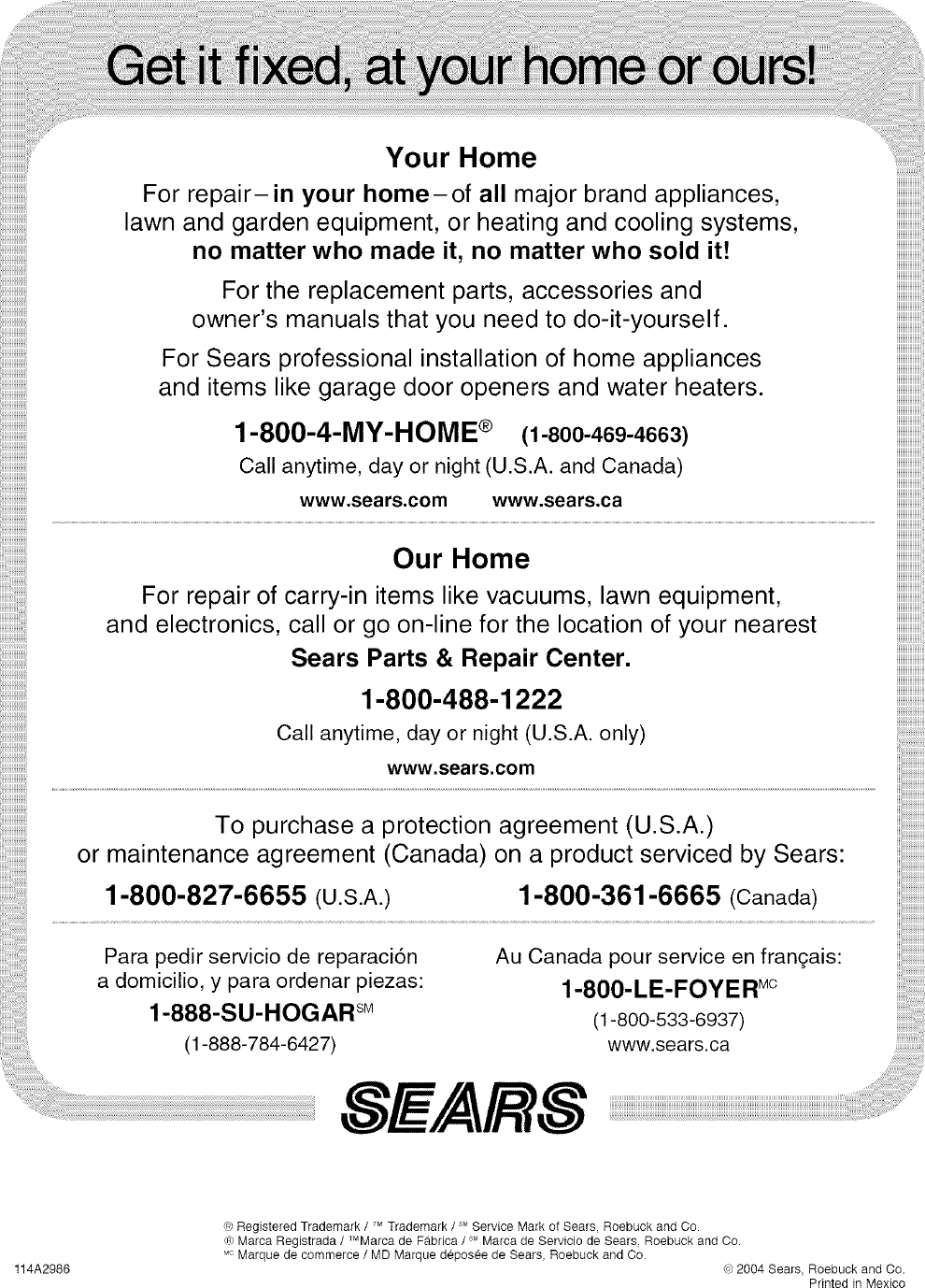Craftsman 1395364812 garage door opener manual
Are you looking for information on using the Craftsman 1395364812 garage door opener? This user manual contains important warranty, safety, and product feature information. View the user manual below for more details. Want a copy for yourself? Download or print a free copy of the user manual below.
Owner’s Manual/Manual Del Propietario

1/2 HP
GARAGE DOOR OPENER ABRIDOR DE PUERTA DE COCHERA
For Residential Use Only/Sólo para uso residencial
Model/Modelos • 139.5364812

| ENGLISH | ESPAÑOL |
|---|---|
| Read and follow all safety rules and operating instructions before first use of this product. | Leer y seguir todas las reglas de seguridad y las instrucciones de operación antes de usar este producto por primera vez. |
| Fasten the manual near the garage door after installation. | Guardar este manual cerca de la puerta de la cochera. |
| Periodic checks of the opener are required to ensure safe operation. | Se deben realizar revisiones periódicas del abridor de puertas para asegurar su operación segura. |

Sears, Roebuck and Co., Hoffman Estates, IL 60179 U.S.A
TABLE OF CONTENTS
- Introduction
- Assembly
- Installation
- Installation safety instructions
- Determine the header bracket location
- Install the header bracket
- Attach the rail to the header bracket
- Position the opener
- Hang the opener
- Install the door control
- Install the light
- Attach the emergency release rope and handle
- Electrical requirements
- Install the Protector System®
- Fasten the door bracket 23-24
- Connect the door arm to the trolley
- Adjustment
- Operation
- Programming
- Repair Parts
- Accessories
- Warranty
- Repair Parts and Service
INTRODUCTION
Safety Symbol and Signal Word Review
This garage door opener has been designed and tested to offer safe service provided it is installed, operated, maintained and tested in strict accordance with the instructions and warnings contained in this manual.

When you see these Safety Symbols and Signal Words on the following pages, they will alert you to the possibility of serious injury or death if you do not comply with the warnings that accompany them. The hazard may come from something mechanical or from electric shock. Read the warnings carefully.
When you see this Signal Word on the following pages, it will alert you to the possibility of damage to your garage door and/or the garage door opener if you do not comply with the cautionary statements that accompany it. Read them carefully.
Preparing your garage door
Before you begin:
- Disable locks.
- Remove any ropes connected to garage door.
- Complete the following test to make sure your garage door is balanced and is not sticking or binding:
- Lift the door about halfway as shown. Release the door. If balanced, it should stay in place, supported entirely by its springs.
- Raise and lower the door to see if there is any binding or sticking.
If your door binds, sticks, or is out of balance, call a trained door systems technician.
 WARNING
WARNING
To prevent possible SERIOUS INJURY OR DEATH:
- ALWAYS call a trained door systems technician if garage door binds, sticks, or is out of balance. An unbalanced garage door may not reverse when required.
- NEVER try to loosen, move or adjust garage door, door springs, cables, pulleys, brackets or their hardware, all of which are under EXTREME tension.
- Disable ALL locks and remove ALL ropes connected to garage door BEFORE installing and operating garage door opener to avoid entanglement.
CAUTION
To prevent damage to garage door and opener:
- ALWAYS disable locks BEFORE installing and operating the opener.
- ONLY operate garage door opener at 120V, 60 Hz to avoid malfunction and damage.

Tools needed
During assembly, installation and adjustment of the opener, instructions will call for hand tools as illustrated below.
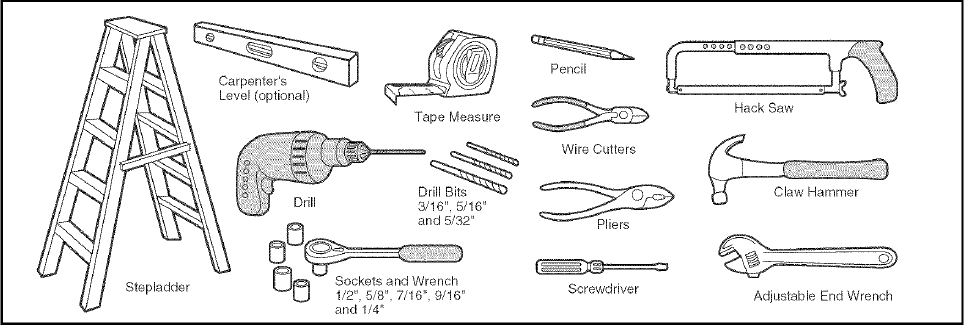
Planning
Identify the type and height of your garage door. Survey your garage area to see if any of the conditions below apply to your installation. Additional materials may be required. You may find it helpful to refer back to this page and the accompanying illustrations as you proceed with the installation of your opener.
Depending on your requirements, there are several installation steps which may call for materials or hardware not included in the carton.
- Installation Step 1 – Look at the wall or ceiling above the garage door. The header bracket must be securely fastened to structural supports.
- Installation Step 5 – Do you have a finished ceiling in your garage? If so, a support bracket and additional fastening hardware may be required.
- Installation Step 10 – Depending upon garage construction, extension brackets or wood blocks may be needed to install sensors.
- Installation Step 10 – Alternate floor mounting of the safety reversing sensor will require hardware not provided.
- Do you have an access door in addition to the garage door? If not, Model 53702 Outside Quick Release is required. See Accessories page.
- Look at the garage door where it meets the floor. Any gap between the floor and the bottom of the door must not exceed 1/4" (6 mm). Otherwise, the safety reversal system may not work properly. See Adjustment Step 3. Floor or door should be repaired.
SECTIONAL DOOR INSTALLATIONS
- Do you have a steel, aluminum, fiberglass or glass panel door? If so, horizontal and vertical reinforcement is required (Installation Step 11).
- The opener should be installed above the center of the door. If there is a torsion spring or center bearing plate in the way of the header bracket, it may be installed within 4 feet (1.2 m) to the left or right of the door center. See Installation Steps 1 and 11.
- If your door is more than 7 feet (2.1 m) high, see rail extension kits listed on Accessories page.
SECTIONAL DOOR INSTALLATION

ONE-PIECE DOOR INSTALLATIONS
- Generally, a one-piece door does not require reinforcement. If your door is lightweight, refer to the information relating to sectional doors in Installation Step 11.
- Depending on your door’s construction, you may need additional mounting hardware for the door bracket (Step 11).
 WARNING
WARNING
Without a properly working safety reversal system, persons (particularly small children) could be SERIOUSLY INJURED or KILLED by a closing garage door.
- The gap between the bottom of the garage door and the floor MUST NOT exceed 1/4” (6 mm). Otherwise, the safety reversal system may not work properly.
- The floor or the garage door MUST be repaired to eliminate the gap.
ONE-PIECE DOOR WITHOUT TRACK

ONE-PIECE DOOR WITHOUT TRACK
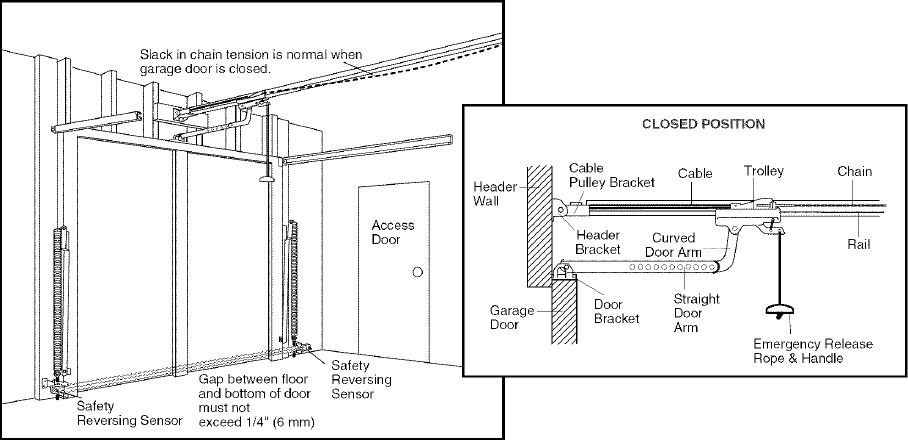
Carton Inventory
Your garage door opener is packaged in two cartons which contain the motor unit and all parts illustrated below. Accessories will depend on the model purchased. If anything is missing, carefully check the packing material. Parts may be stuck in the foam. Hardware for assembly and installation is shown on the next page. Save the carton and packing material until installation and adjustment is complete.
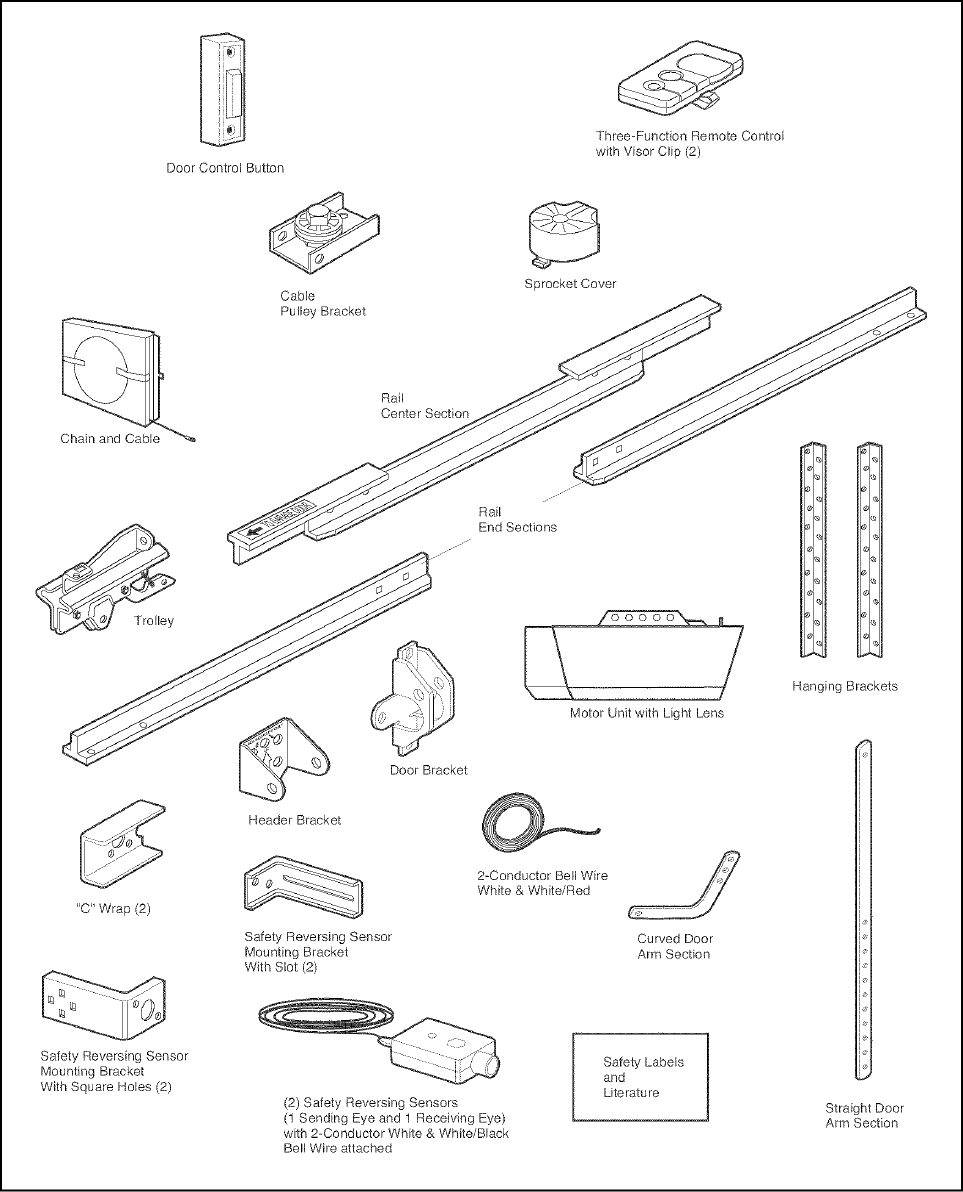
Hardware Inventory
Separate all hardware and group as shown below for the assembly and installation procedures.
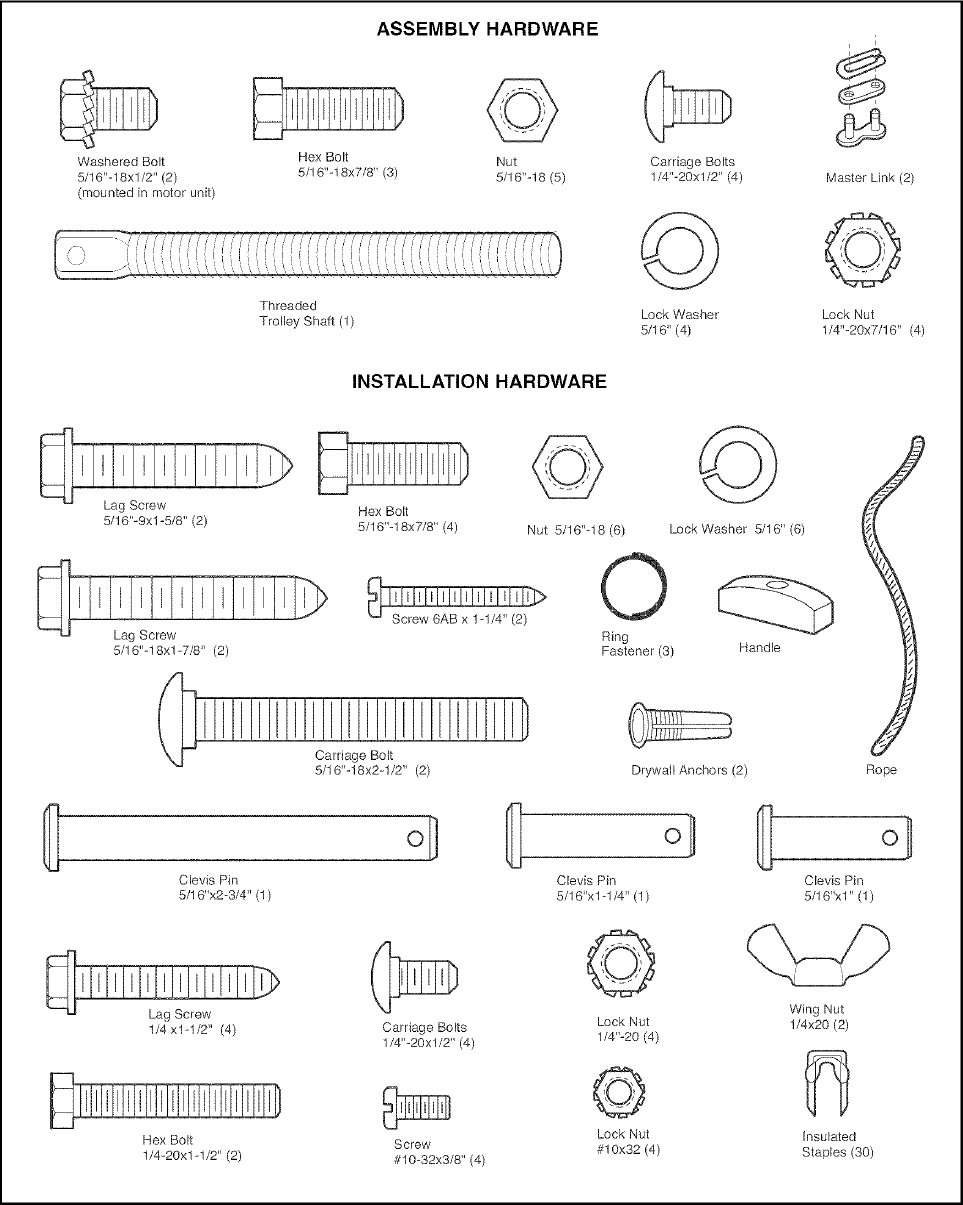
ASSEMBLY STEP 1
Assemble the Rail and Attach the Cable Pulley Bracket
To avoid installation difficulties, do not run the garage door opener until instructed to do so.
Align the three rail sections on a flat surface exactly as shown. Front and back sections are interchangeable for ease of assembly.
Insert the carriage bolts so the square bolt necks seat in the square holes in the rail sections and pass through the round holes in the center section rail. Make sure bolt necks are seated in the square holes and rails are aligned before you tighten lock nuts. Improper assembly can cause jerky trolley operation, noise and/or nuisance door reversals.
Assemble lock nuts, ensure alignment and tighten.
NOTE: If rail is not assembled exactly as shown, trolley will not travel smoothly along length of rail or it will hit against nuts.
Position the cable pulley bracket on the front end of the rail as shown. Fasten securely with the hardware shown.
NOTE: When tightening the bolts, be sure to keep bracket parallel to the rail. Otherwise, the rail may bow when the opener is operated.
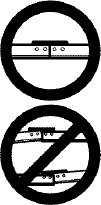
HARDWARE SHOWN ACTUAL SIZE
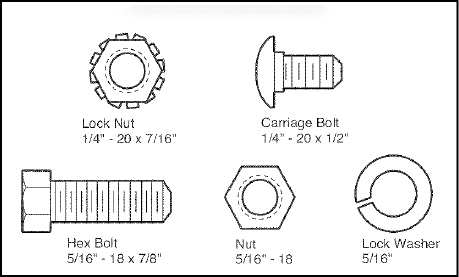
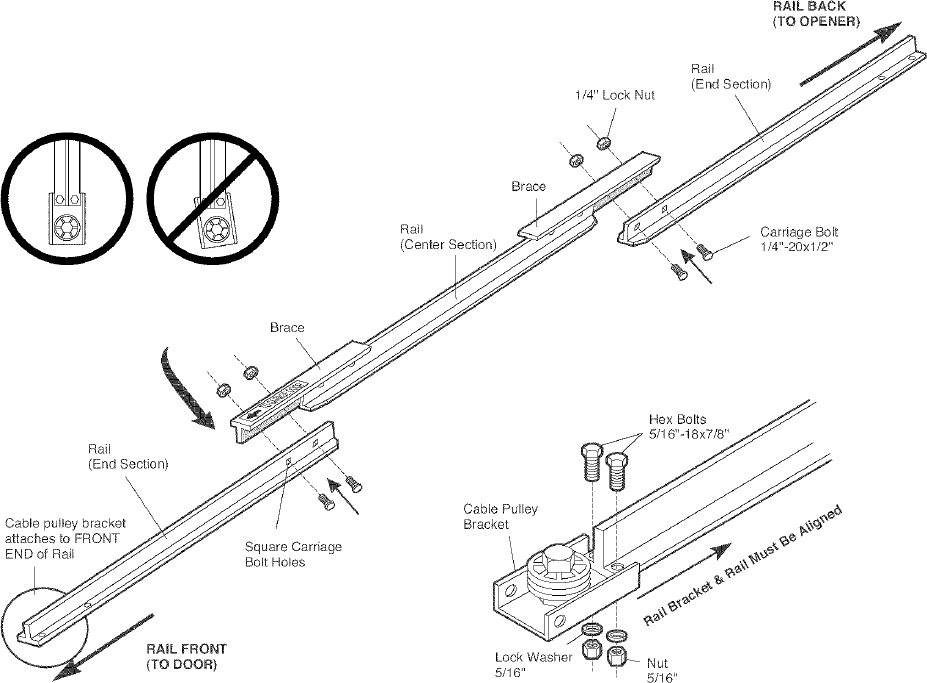
ASSEMBLY STEP 2
Install the Trolley
Attach the trolley threaded shaft to the trolley with the lock washer and nuts as shown.
As a temporary stop, insert a screwdriver into the hole in the front end of the rail.
Slide the trolley assembly along the rail to the screwdriver stop.
NOTE: If trolley hits against any nuts on the rail, the bolts and nuts were attached from the wrong side and must be repositioned. Review Assembly Step 1.
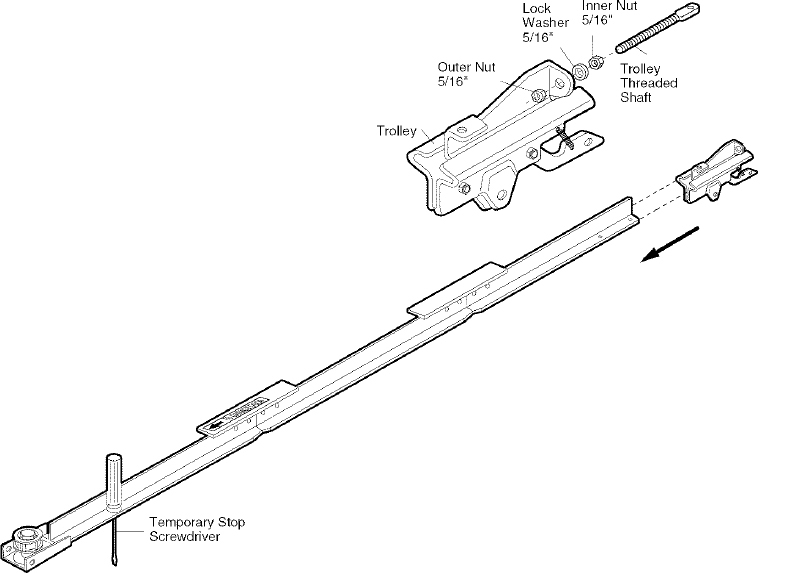
HARDWARE SHOWN ACTUAL SIZE
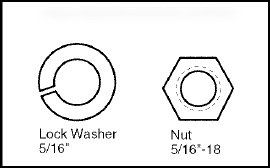
ASSEMBLY STEP 3
Attach the Rail to the Motor Unit
To avoid installation difficulties, do not run the garage door opener until instructed to do so.
- Place the opener on packing material to protect the cover. For convenience, put a support under the cable pulley bracket.
- Remove the two washered bolts mounted in top of motor unit.
- Align the holes in the back section of the rail with the holes in the motor unit.
- Fasten the rail with the two washered bolts previously removed. Tighten securely.
Use only these bolts! Use of any other bolts will cause serious damage to door opener.
- Insert a 5/16"-18x7/8" hex bolt into the cover protection bolt hole in the rail as shown. Tighten securely with a 5/16" lock washer and nut.
NOTE: This bolt prevents trolley over-travel. Keep a 2" (5 mm) minimum between the trolley and this bolt when adjusting travel limits (see page 27).
HARDWARE SHOWN ACTUAL SIZE
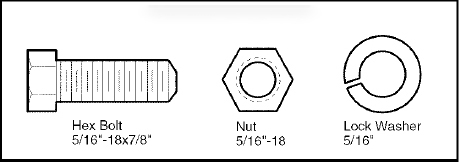
CAUTION
To avoid SERIOUS damage to opener, ONLY use bolts/fasteners mounted in top of motor unit.
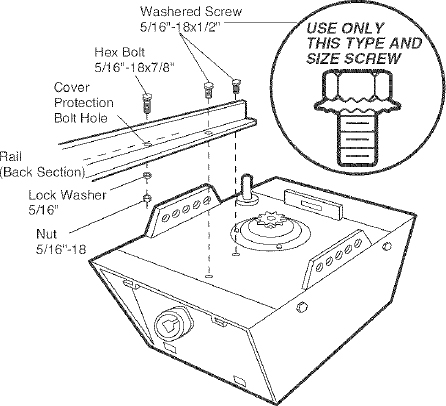
ASSEMBLY STEP 4
Install the Chain/Cable and Attach the Sprocket Cover
INSTALLING THE CHAIN/CABLE
- Pull the cable loop from the carton and fasten it to the trolley with a master link from the hardware bag (Figure 1).
- Push pins of master link bar through cable loop and hole in front end of trolley.
- Push master link cap over pins and past pin notches.
- Slide clip-on spring over cap and onto pin notches until both pins are securely locked in place.
- With the trolley against the screwdriver, dispense the cable around the pulley.
- Continue along the rail and around the motor unit sprocket (Figure 2). The sprocket teeth must engage the chain. Continue forward to the trolley threaded shaft.
- Use the second master link to connect the chain to the flat end of the shaft (Figure 1). Check to make sure the chain is not twisted.
- Remove the screwdriver.
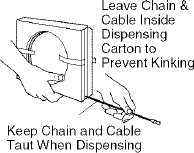
ATTACHING THE SPROCKET COVER Insert the back tab in the slot on the back of the mounting plate. Squeeze the cover slightly and insert the front tab (Figure 3).
 WARNING
WARNING
To avoid possible SERIOUS INJURY to fingers from moving garage door opener:
- ALWAYS keep hand clear of sprocket while operating opener.
- Securely attach sprocket cover BEFORE operating.
Figure 1
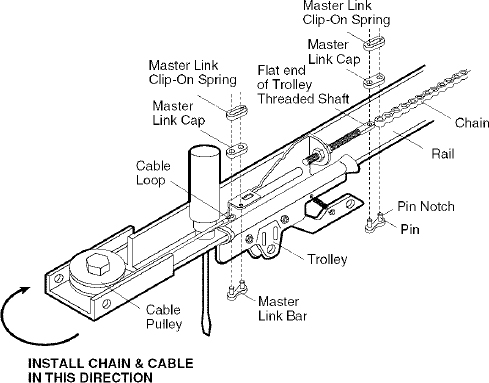
Figure 2
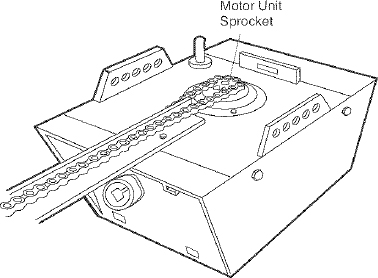
Figure 3
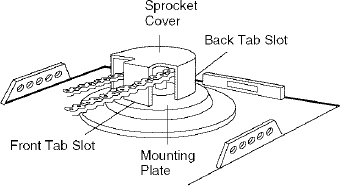
ASSEMBLY STEP 5
Tighten the Chain and Cable
- Spin the inner nut and lock washer down the threaded shaft, away from the trolley.
- To tighten the chain, turn outer nut in the direction shown. As you turn the nut, keep the chain from twisting.
- When the chain is approximately 1/2" (13 mm) above the base of the rail at its midpoint, re-tighten the inner nut to secure the adjustment.
Sprocket noise can result if chain is either too loose or too tight.
When installation is complete, you may notice some chain droop with the door closed. This is normal. If the chain returns to the position shown when the door is open, do not re-adjust the chain.
NOTE: During future maintenance, ALWAYS pull the emergency release handle to disconnect trolley before adjusting chain.
You have now finished assembling your garage door opener. Please read the following warnings before proceeding to the installation section.
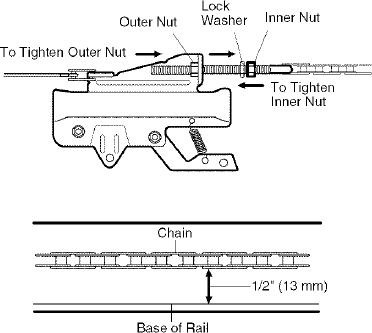
INSTALLATION
IMPORTANT INSTALLATION INSTRUCTIONS
 WARNING
WARNING
To reduce the risk of severe injury or death:
- READ AND FOLLOW ALL INSTALLATION WARNINGS AND INSTRUCTIONS.
- Install garage door opener only on properly balanced and lubricated garage door. An improperly balanced door may not reverse when required and could result in SEVERE INJURY or DEATH.
- All repairs to cables, spring assemblies and other hardware MUST be made by a trained door systems technician BEFORE installing opener.
- Disable all locks and remove all ropes connected to garage door BEFORE installing opener to avoid entanglement.
- Install garage door opener 7 feet (2.1 m) or more above floor.
- Mount emergency release handle 6 feet (1.8 m) above floor.
- NEVER connect garage door opener to power source until instructed to do so.
- NEVER wear watches, rings or loose clothing while installing or servicing opener. They could be caught in garage door or opener mechanisms.
- Install wall-mounted garage door control:
- within sight of the garage door
- out of reach of children at minimum height of 5 feet (1.5 m)
- away from all moving parts of the door.
- Place entrapment warning label on wall next to garage door control.
- Place manual release/safety reverse test label in plain view on inside of garage door.
- Upon completion of installation, test safety reversal system. Door MUST reverse on contact with a 1-1/2" (3.8 cm) high object (or a 2×4 laid flat) on the floor.
INSTALLATION STEP 1
Determine the Header Bracket Location
 WARNING
WARNING
To prevent possible SERIOUS INJURY or DEATH:
- Header bracket MUST be RIGIDLY fastened to structural support on header wall or ceiling, otherwise garage door might not reverse when required. DO NOT install header bracket over drywall.
- Concrete anchors MUST be used if mounting header bracket or 2×4 into masonry.
- NEVER try to loosen, move or adjust garage door, springs, cables, pulleys, brackets, or their hardware, all of which are under EXTREME tension.
- ALWAYS call a trained door systems technician if garage door binds, sticks, or is out of balance. An unbalanced garage door might not reverse when required.
Installation procedures vary according to garage door types. Follow the instructions which apply to your door.
Close the door and mark the inside vertical centerline of the garage door.
Extend the line onto the header wall above the door. You can fasten the header bracket within 4 feet (1.22 m) of the left or right of the door center only if a torsion spring or center bearing plate is in the way; or you can attach it to the ceiling (see page 13) when clearance is minimal. (It may be mounted on the wall upside down if necessary, to gain approximately 1/2" (13 mm). If you need to install the header bracket on a 2×4 (on wall or ceiling), use lag screws (not provided) to securely fasten the 2×4 to structural supports as shown here and on page 13.
Open your door to the highest point of travel as shown. Draw an intersecting horizontal line on the header wall above the high point:
- 2" (5 cm) above the high point for sectional door and one-piece door with track.
- 8" (20 cm) above the high point for one-piece door without track.
This height will provide travel clearance for the top edge of the door.
NOTE: If the total number of inches exceeds the height available in your garage, use the maximum height possible, or refer to page 13 for ceiling installation.
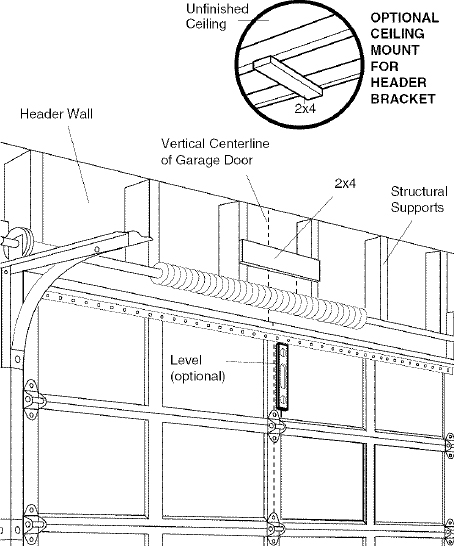
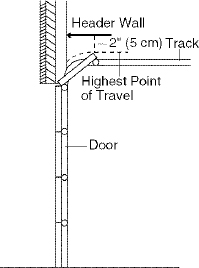
Sectional door with curved track
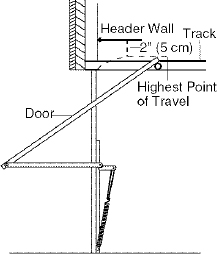
One-piece door with horizontal track
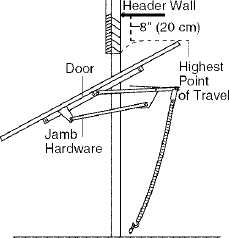
One-piece door without track: jamb hardware
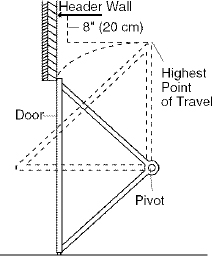
One-piece door without track: pivot hardware
INSTALLATION STEP 2
Install the Header Bracket
You can attach the header bracket either to the wail above the garage door, or to the ceiling. Follow the instructions which will work best for your particular requirements. Do not install the header bracket over drywall, If installing into masonry, use concrete anchors (not provided).
WALL HEADER BRACKET INSTALLATION
- Center the bracket on the vertical centerline with the bottom edge of the bracket on the horizontal line as shown (with the arrow pointing toward the ceiling).
- Mark the vertical set of bracket holes (do not use the holes designated for ceiling mount). Drill 3/16" pilot holes and fasten the bracket securely to a structural support with the hardware provided.
HARDWARE SHOWN ACTUAL SIZE
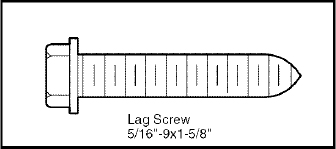
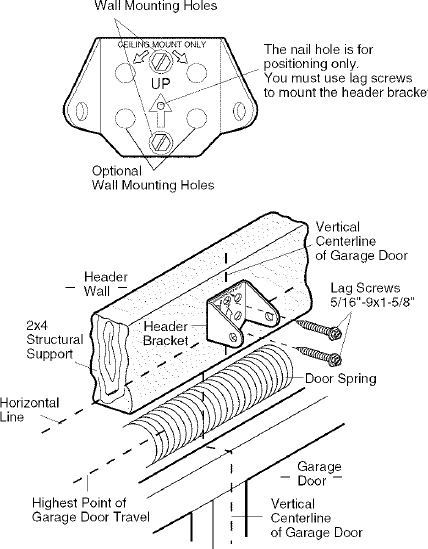
CEILING HEADER BRACKET INSTALLATION
- Extend the vertical centerline onto the ceiling as shown.
- Center the bracket on the vertical mark, no more than 6" (15 cm) from the wall. Make sure the arrow is pointing toward the wall. The bracket can be mounted flush against the ceiling when clearance is minimal.
- Mark the side holes. Drill 3/16" pilot holes and fasten bracket securely to a structural support with the hardware provided.
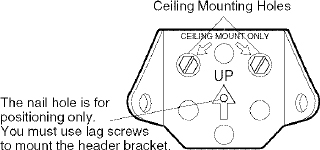
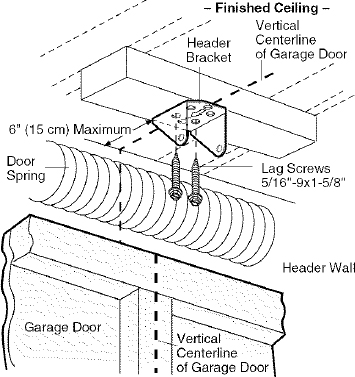
INSTALLATION STEP 3
Attach the Rail to the Header Bracket
- Position the opener on the garage floor below the header bracket. Use packing material as a protective base. NOTE: If the door spring is in the way you’ll need help. Have someone hold the opener securely on a temporary support to allow the rail to clear the spring.
- Position the rail bracket against the header bracket.
- Align the bracket holes and join with a clevis pin as shown.
- Insert a ring fastener to secure.
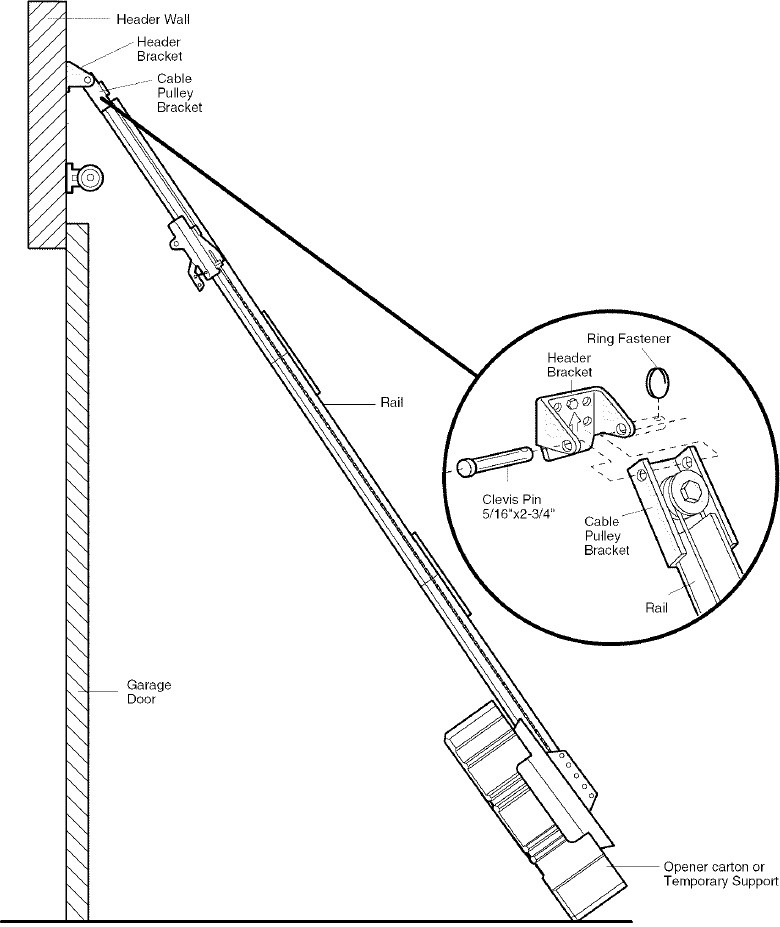
HARDWARE SHOWN ACTUAL SIZE

INSTALLATION STEP 4
Position the Opener
Follow instructions which apply to your door type as illustrated.
SECTIONAL DOOR OR ONE-PIECE DOOR WITH TRACK
A 2×4 laid flat is convenient for setting an ideal door-to-rail distance.
- Remove foam packaging.
- Raise the opener onto a stepladder. You will need help at this point if the ladder is not tall enough.
- Open the door all the way and place a 2×4 laid flat on the top section beneath the rail.
- If the top section or panel hits the trolley when you raise the door, pull down on the trolley release arm to disconnect inner and outer sections. Slide the outer trolley toward the motor unit. The trolley can remain disconnected until Installation Step 12 is completed.

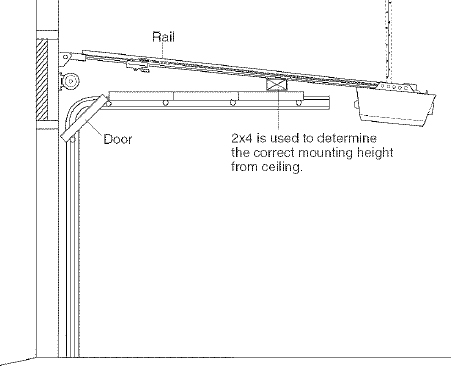
CAUTION
To prevent damage to garage door, rest garage door opener rail on 2×4 placed on top section of door.
ONE-PIECE DOOR WITHOUT TRACK
A 2×4 on its side is convenient for setting an ideal door-to-rail distance.
- Remove foam packaging.
- Raise the opener onto a stepladder. You will need help at this point if the ladder is not tall enough.
- Open the door all the way and place a 2×4 on its side on the top section of the door beneath the rail.
- The top of the door should be level with the top of the motor unit. Do not position the opener more than 4" (10 cm) above this point.
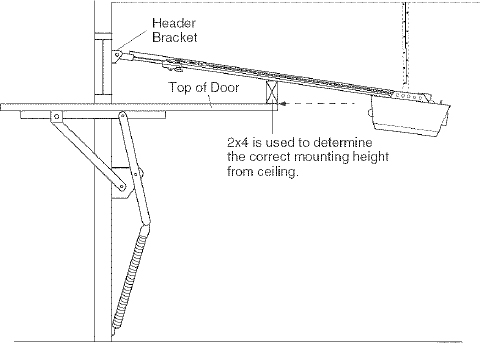
INSTALLATION STEP 5
Hang the Opener
Three representative installations are shown. Yours may be different. Hanging brackets should be angled (Figure 1) to provide rigid support. On finished ceilings (Figure 2 and Figure 3), attach a sturdy metal bracket to structural supports before installing the opener. This bracket and fastening hardware are not provided.
- Measure the distance from each side of the motor unit to the structural support.
- Cut both pieces of the hanging bracket to required lengths.
- Drill 3/16" pilot holes in the structural supports.
- Attach one end of each bracket to a support with 5/16"-18×1 -7/8" lag screws.
- Fasten the opener to the hanging brackets with 5/16"-18x7/8" hex bolts, lock washers and nuts.
- Check to make sure the rail is centered over the door (or in line with the header bracket if the bracket is not centered above the door).
- Remove the 2×4. Operate the door manually. If the door hits the rail, raise the header bracket.
NOTE: DO NOT connect power to opener at this time.
HARDWARE SHOWN ACTUAL SIZE
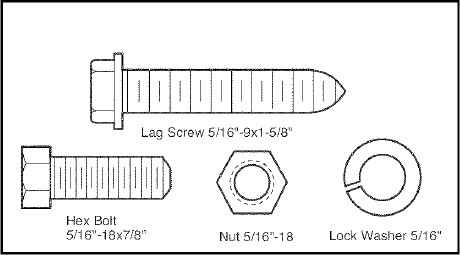
 WARNING
WARNING
To avoid possible SERIOUS INJURY from a falling garage door opener, fasten it SECURELY to structural supports of the garage. Concrete anchors MUST be used if installing any brackets into masonry.
Figure 1
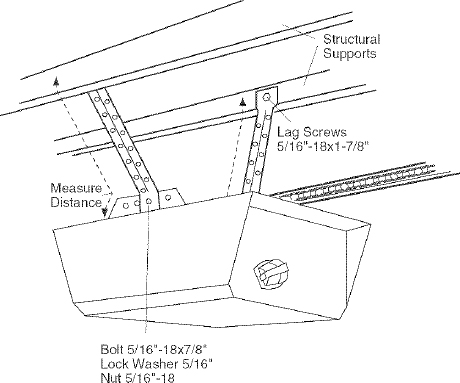
Figure 2
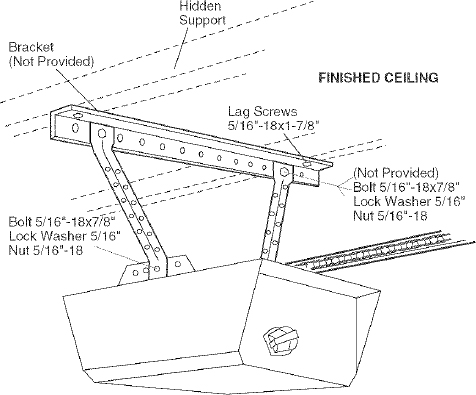
Figure 3
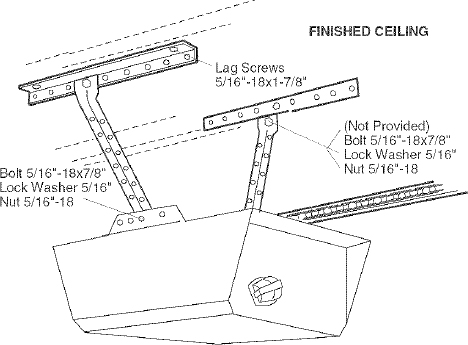
INSTALLATION STEP 6
Install the Door Control
Locate door control within sight of door, at a minimum height of 5 feet (1.5 m) where small children cannot reach, away from moving parts of door and door hardware. If installing into drywall, drill 5/32" holes and use the anchors provided.
- Strip 1/4" (6 mm) of insulation from one end of bell wire and connect to the two terminal screws on back of door control by color: white to 2 and white/red to 1.
- Door Control Button: Fasten securely with screws 6AB×1-1/2".
- (For standard installation only) Run bell wire up wall and across ceiling to motor unit. Use insulated staples to secure wire in several places. Do not pierce wire with a staple, creating a short or open circuit.
- Connect the bell wire to the terminal screws on the motor unit panel: white to 2; white/red to 1.
- Position the antenna wire as shown.

 WARNING
WARNING
To prevent possible SERIOUS INJURY or DEATH from electrocution:
- Be sure power is not connected BEFORE installing door control.
- Connect ONLY to 24 VOLT low voltage wires.
To prevent possible SERIOUS INJURY or DEATH from a closing garage door:
- Install door control within sight of garage door, out of reach of children at a minimum height of 5 feet (1.5 m), and away from all moving parts of door.
- NEVER permit children to operate or play with door control push buttons or remote control transmitters.
- Activate door ONLY when it can be seen clearly, is properly adjusted, and there are no obstructions to door travel.
- ALWAYS keep garage door in sight until completely closed. NEVER permit anyone to cross path of closing garage door.
HARDWARE SHOWN ACTUAL SIZE
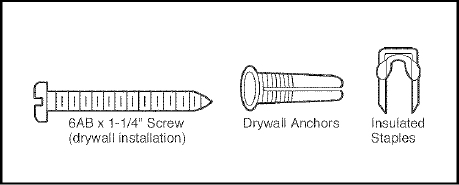
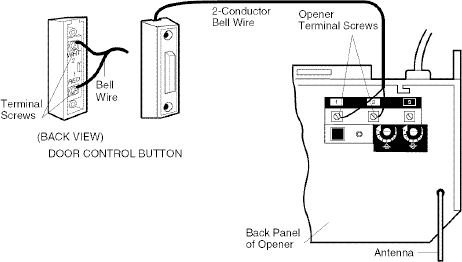
INSTALLATION STEP 7
Install the Light
- Install a 75 watt maximum light bulb in the socket. The light will turn ON and remain lit for approximately 4-1/2 minutes when power is connected. Then the light will turn OFF.
- Apply slight pressure on the sides of the lens and slide the tabs into the slots in the end panel (See illustration).
- To remove, reverse the procedure. Use care to avoid snapping off lens tabs.
- If the bulb burns out prematurely due to vibration, replace with a Garage Door Opener bulb.
NOTE: Use only a standard light bulb. The use of a short neck or speciality light bulb may overheat the endpanel or light socket.
CAUTION
To prevent possible OVERHEATING of the endpanel or light socket,
- DO NOT use short neck or specialty light bulbs.
- DO NOT use halogen bulbs. Use ONLY incandescent.
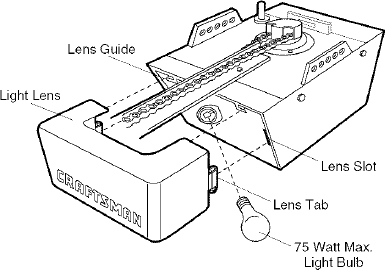
INSTALLATION STEP 8
Attach the Emergency Release Rope and Handle
- Thread one end of the rope through the hole in the top of the red handle so “NOTICE” reads right side up as shown. Secure with an overhand knot at least 1" (25 mm) from the end of the rope to prevent slipping.
- Thread the other end of the rope through the hole in the release arm of the outer trolley.
- Adjust rope length so the handle is 6 feet (1.8 m) above the floor. Secure with an overhand knot.
NOTE: If it is necessary to cut the rope, heat seal the cut end with a match or lighter to prevent unraveling.
 WARNING
WARNING
To prevent possible SERIOUS INJURY or DEATH from a falling garage door:
- If possible, use emergency release handle to disengage trolley ONLY when garage door is CLOSED. Weak or broken springs or unbalanced door could result in an open door falling rapidly and/or unexpectedly.
- NEVER use emergency release handle unless garage doorway is clear of persons and obstructions.
NEVER use handle to pull door open or closed. If rope knot becomes untied, you could fall.
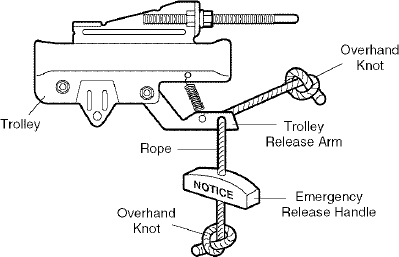
INSTALLATION STEP 9
Electrical Requirements
To avoid installation difficulties, do not run the opener at this time.
To reduce the risk of electric shock, your garage door opener has a grounding type plug with a third grounding pin. This plug will only fit into a grounding type outlet. If the plug doesn’t fit into the outlet you have, contact a qualified electrician to install the proper outlet.
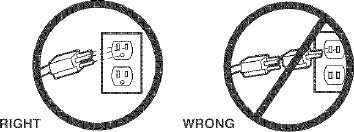
If permanent wiring is required by your local code, refer to the following procedure.
To make a permanent connection through the 7/8" hole in the top of the motor unit:
- Remove the motor unit cover screws and set the cover aside.
- Remove the attached 3-prong cord.
- Connect the black (line) wire to the screw on the brass terminal; the white (neutral) wire to the screw on the silver terminal; and the ground wire to the green ground screw. The opener must be grounded.
- Reinstall the cover.
To avoid installation difficulties, do not run the opener at this time.
 WARNING
WARNING
To prevent possible SERIOUS INJURY or DEATH from electrocution or fire:
- Be sure power is not connected to the opener, and disconnect power to circuit BEFORE removing cover to establish permanent wiring connection.
- Garage door installation and wiring MUST be in compliance with all local electrical and building codes.
- NEVER use an extension cord, 2-wire adapter, or change plug in any way to make it fit outlet. Be sure the opener is grounded.
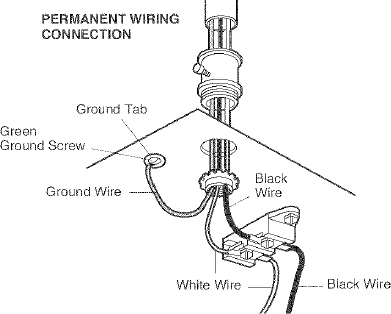
INSTALLATION STEP 10
Install The Protector System®
The safety reversing sensor must be connected and aligned correctly before the garage door opener will move in the down direction.
IMPORTANT INFORMATION ABOUT THE SAFETY REVERSING SENSOR
When properly connected and aligned, the sensor will detect an obstacle in the path of its electronic beam. The sending eye (with an green indicator light) transmits an invisible light beam to the receiving eye (with a green indicator light). If an obstruction breaks the light beam while the door is closing, the door will stop and reverse to full open position, and the opener lights will flash 10 times.
The units must be installed inside the garage so that the sending and receiving eyes face each other across the door, no more than 6" (15 cm) above the floor. Either can be installed on the left or right of the door as long as the sun never shines directly into the receiving eye lens.
The mounting brackets are designed to clip onto the track of sectional garage doors without additional hardware.
 WARNING
WARNING
Be sure power is not connected to the garage door opener BEFORE installing the safety reversing sensor. To prevent SERIOUS INJURY or DEATH from a closing garage door:
- Correctly connect and align the safety reversing sensor. This required safety device MUST NOT be disabled.
- Install the safety reversing sensor so beam is NO HIGHER than 6" (15 cm) above garage floor.
If it is necessary to mount the units on the wall, the brackets must be securely fastened to a solid surface such as the wall framing. Extension brackets (see accessories) are available if needed. If installing in masonry construction, add a piece of wood at each location to avoid drilling extra holes in masonry if repositioning is necessary.
The invisible light beam path must be unobstructed. No part of the garage door (or door tracks, springs, hinges, rollers or other hardware) may interrupt the beam while the door is closing.
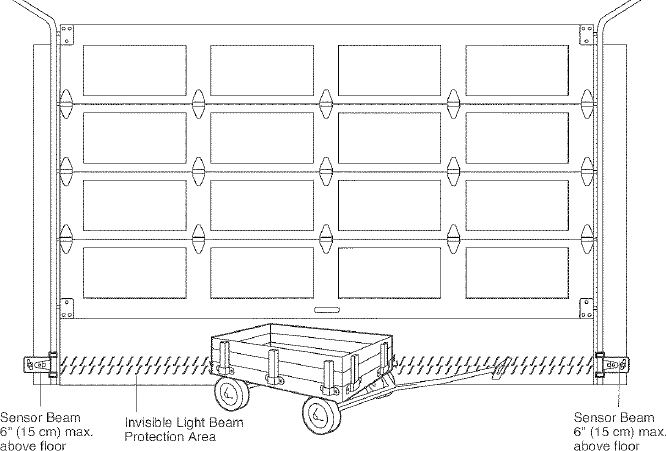
Facing the door from inside the garage
INSTALLING THE BRACKETS
Figure 1, 2 and 3 show recommended assembly of bracket(s) and “C” wrap based on the wall installation of the sensors on each side of the garage door as shown on page 20, or on the garage door tracks themselves.
Figure 4 and 5 are variations which may fit your installation requirements better. Make sure the wraps and brackets are aligned so the sensors will face each other across the garage door.
Figure 1
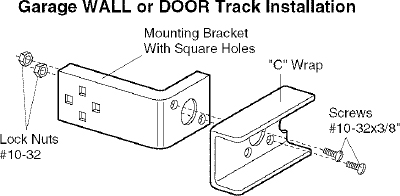
Figure 2
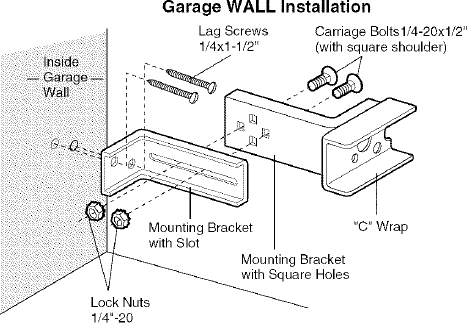
Figure 3
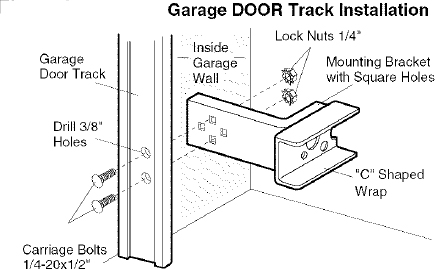
Figure 4
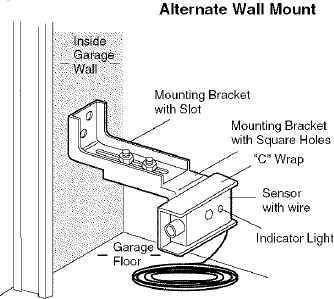
Figure 5
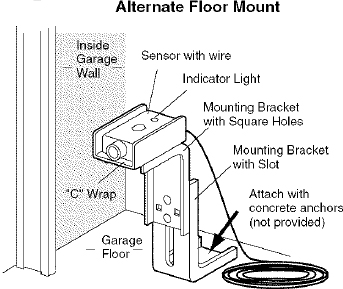
Garage Wall or Door Track Installation
- Fasten the “C” wraps to the mounting brackets having square holes, using th hardware shown in Figure 1.
Garage Wall Installation
- Connect each assembly to a slotted bracket, using the hardware show on Figure 2. Note alignment of brackets for left and right sides of door.
- Finger tighten the lock nuts.
- Use bracket mounting holes as a template to locate and drill (2) 3/16" diameter pilot holes on both sides of the garage door, 4"-6" above the floor but not exceeding 6" (see warning on page 20).
- Attach bracket assembly with 1/4"×1 -1/2" lag screws as shown in Figure 2.
- Adjust right and left bracket assemblies to the same distance out from mounting surface. Make sure all door hardware obstructions are cleared. Tighten the nuts securely.
Garage Door Track Installation
Discard slotted bracket. Drill 3/8" holes in each track and fasten securely with hardware as shown in Figure 3.
HARDWARE SHOWN ACTUAL SIZE

MOUNTING AND WIRING THE SAFETY SENSORS
- Slide a 1/4"-20×1/2" carriage bolt head into the slot on each sensor. Use wing nuts to fasten sensors to brackets, with lenses pointing toward each other across the door. Be sure the lens is not obstructed by a bracket extension (Figure 6).
- Finger tighten the wing nuts.
- Run the wires from both sensors to the opener. Use insulated staples to secure wire to wall and ceiling.
- Strip 1/4" (6 mm) of insulation from each set of wires. Separate white and white/black wires sufficiently to connect to the terminal screws: white to 2 and white/black to 3 (Figure 7).
Figure 6
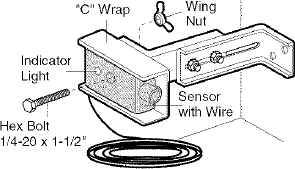
Figure 7
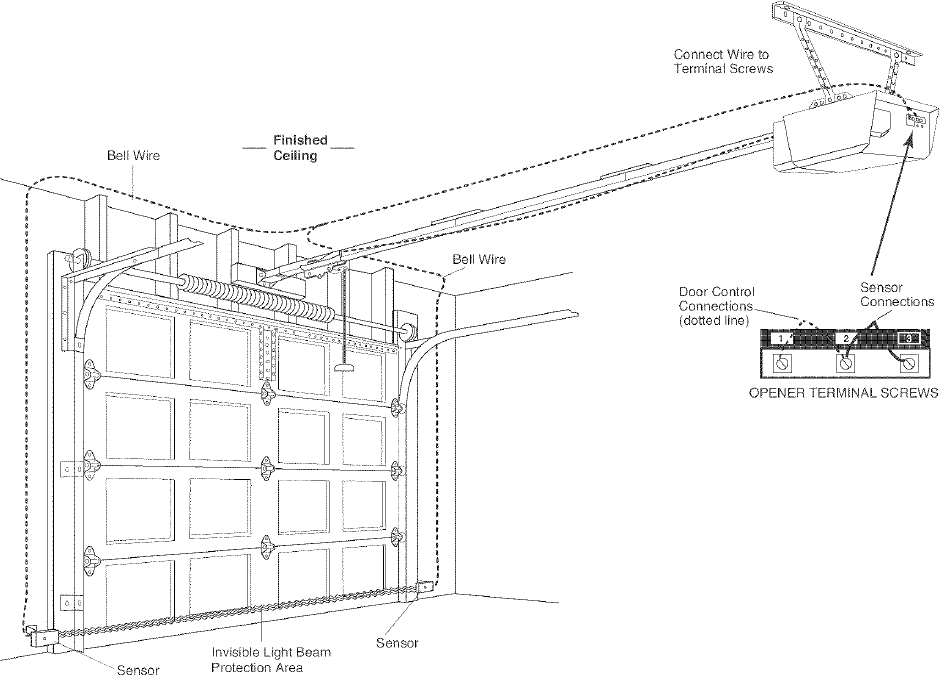
ALIGNING THE SAFETY SENSORS
- Plug in the opener. The indicator lights in both the sending and receiving eyes will glow steadily if wiring connections and alignment are correct.
The sending eye green indicator light will glow regardless of alignment or obstruction. If the green indicator light in the receiving eye is off, dim, or flickering (and the invisible light beam path is not obstructed), alignment is required.
- Loosen the sending eye wing nut and readjust, aiming directly at the receiving eye. Lock in place.
- Loosen the receiving eye wing nut and adjust sensor until it receives the sender’s beam. When the green indicator light glows steadily, tighten the wing nut.
TROUBLESHOOTING THE SAFETY SENSORS
- If the sending eye indicator light does not glow steadily after installation, check for:
- Electric power to the opener.
- A short in the white or white/black wires. These can occur at staples, or at opener connections.
- Incorrect wiring between sensors and opener.
- A broken wire.
- If the sending eye indicator light glows steadily but the receiving eye indicator light doesn’t:
- Check alignment.
- Check for an open wire to the receiving eye.
- If the receiving eye indicator light is dim, realign either sensor.
NOTE: When the invisible beam path is obstructed or misaligned while the door is closing, the door will reverse. If the door is already open, it will not close. The opener lights will blink 10 times. (If bulbs are not installed, 10 clicks can be heard.) See page 20.
INSTALLATION STEP 11
Fasten the Door Bracket
Follow instructions which apply to your door type as illustrated below or on the following page.
A horizontal reinforcement brace should be long enough to be secured to two vertical supports. A vertical reinforcement brace should cover the height of the top panel.
The illustration shows one piece of angle iron as the horizontal brace. For the vertical brace, two pieces of angle iron are used to create a U-shaped support (Figure 1). The best solution is to check with your garage door manufacturer for an opener installation door reinforcement kit.
HARDWARE SHOWN ACTUAL SIZE
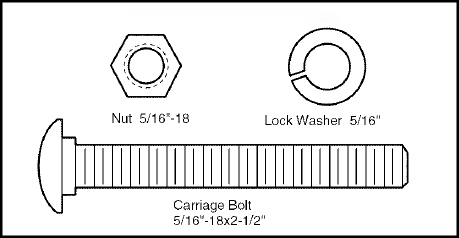
NOTE: Many vertical brace installations provide for direct attachment of the clevis pin and door arm. In this case you will not need the door bracket; proceed to Installation Step 12.
SECTIONAL DOORS
- Center the door bracket on the previously marked vertical centerline used for the header bracket installation. Note correct UP placement, as stamped inside the bracket (Figure 2).
- Position the bracket on the face of the door within the following limits:
- The top edge of the bracket 2"-4" (5-10 cm) below the top edge of the door.
- The top edge of the bracket directly below any structural support across the top of the door.
- Mark and drill 5/16" left and right fastening holes. Secure the bracket as shown in Figure 1 if there is vertical reinforcement.
If your installation doesn’t require vertical reinforcement but does need top and bottom fastening holes for the door bracket, fasten as shown in Figure 2.
Figure 1 and Figure 2
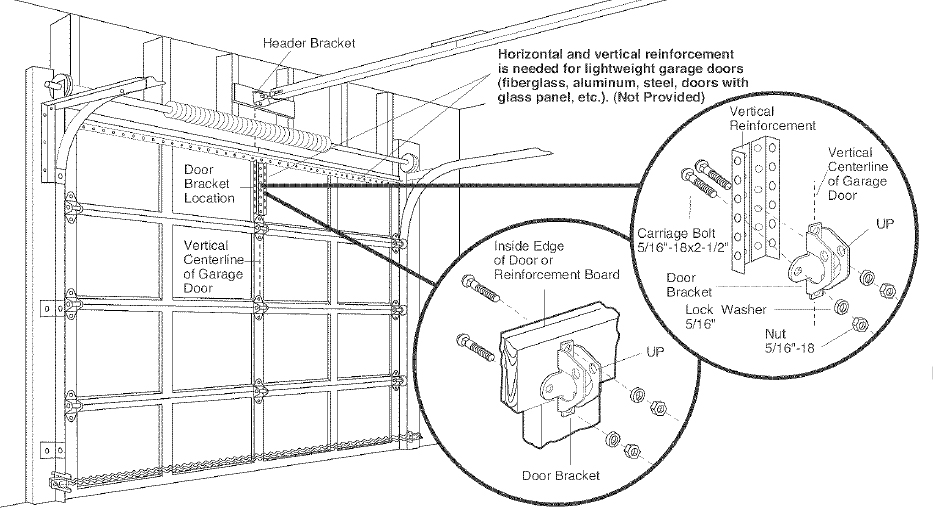
CAUTION
Fiberglass, aluminum or lightweight steel garage doors WILL REQUIRE reinforcement BEFORE installation of door bracket. Contact your door manufacturer for reinforcement kit.
ONE-PIECE DOORS
Please read and comply with the warnings and reinforcement instructions on the previous page. They apply to one-piece doors also.
- Center the door bracket on the top of the door, in line with the header bracket as shown. Mark either the left and right, or the top and bottom holes.
- Drill 5/16" pilot holes and fasten the bracket with hardware supplied.
If the door has no exposed framing, drill 3/16" pilot holes and fasten the bracket with 5/16"×1-1/2" lag screws (not provided) to the top of the door.
NOTE: The door bracket may be installed on the top edge of the door if required for your installation. (Refer to the dotted line optional placement drawing.) Drill 3/16" pilot holes and substitute 5/16"×1-1/2" lag screws (not provided) to fasten the bracket to the door.
HARDWARE SHOWN ACTUAL SIZE
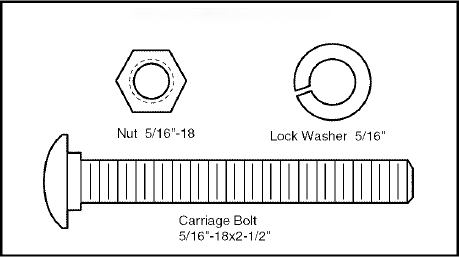
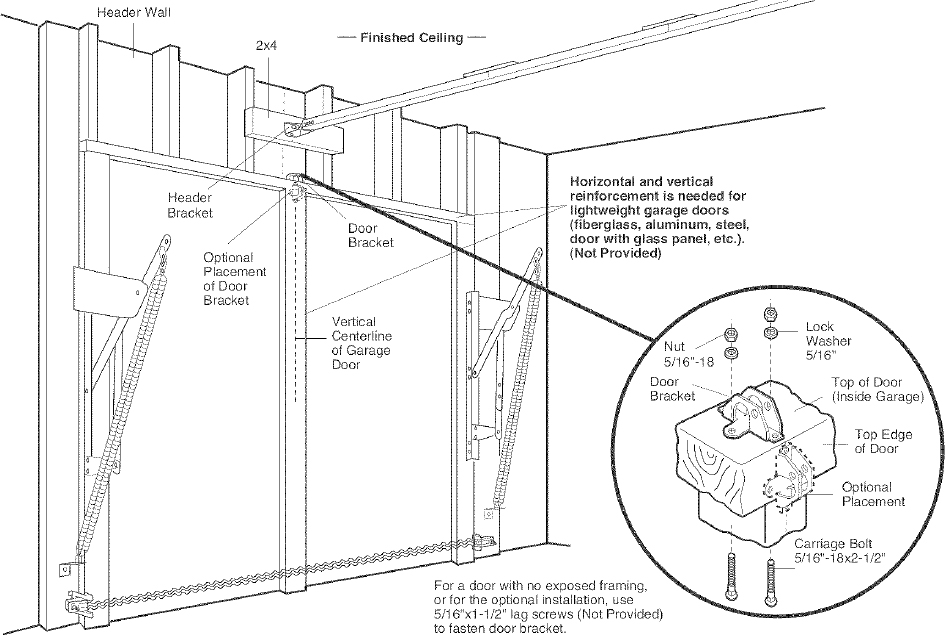
INSTALLATION STEP 12
Connect Door Arm to Trolley
Follow instructions which apply to your door type as illustrated below and on the following page.
SECTIONAL DOORS ONLY
- Make sure garage door is fully closed. Pull the emergency release handle to disconnect the outer trolley from the inner trolley. Slide the outer trolley back (away from the door) about 2" (5 cm) as shown in Figures 1, 2 and 3.
- Figure 1:
- Fasten straight door arm section to outer trolley with the 5/16"×1" clevis pin. Secure the connection with a ring fastener.
- Fasten curved section to the door bracket in the same way, using the 5/16"×1-1/4" clevis pin.
Figure 1
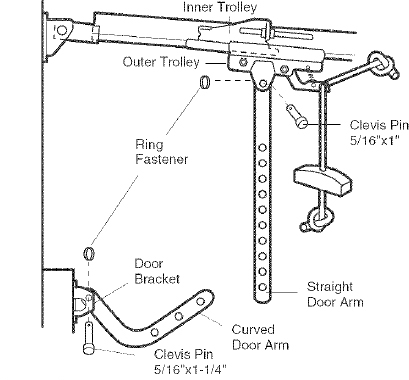
- Figure 2:
- Bring arm sections together. Find two pairs of holes that line up and join sections. Select holes as far apart as possible to increase door arm rigidity.
Figure 2
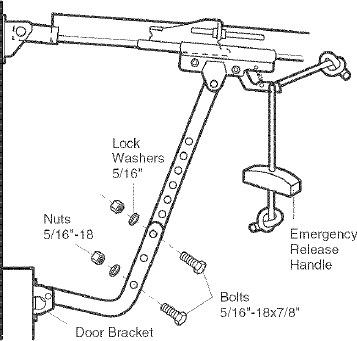
- Figure 3, Hole alignment alternative:
- If holes in curved arm are above holes in straight arm, disconnect straight arm. Cut about 6" (15 cm) from the solid end. Reconnect to trolley with cut end down as shown.
- Bring arm sections together.
- Find two pairs of holes that line up and join with bolts, lock washers and nuts.
- Proceed to Adjustment Step 1, page 27. Trolley will re-engage automatically when opener is operated.
Figure 3
HARDWARE SHOWN ACTUAL SIZE
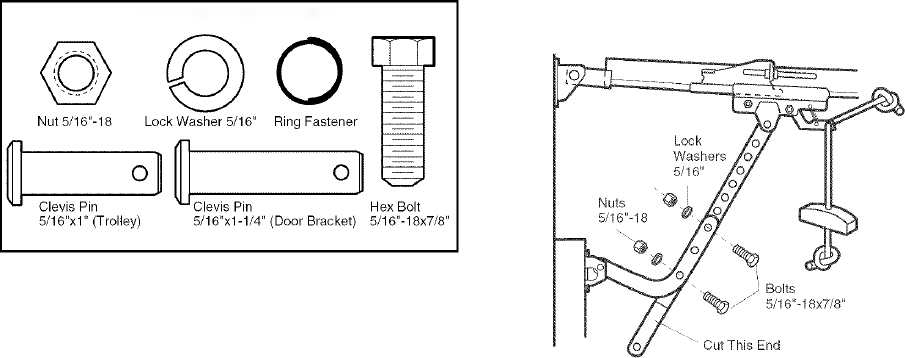
ALL ONE-PIECE DOORS
1. Assemble the door arm, Figure 4:
Figure 4
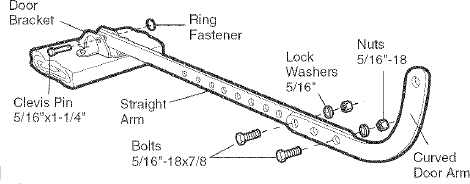
- Fasten the straight and curved door arm sections together to the longest possible length (with a 2 or 3 hole overlap).
- With the door closed, connect the straight door arm section to the door bracket with the 5/16"×1-1/4" clevis pin.
- Secure with a ring fastener.
2. Adjustment procedures, Figure 5:
Figure 5
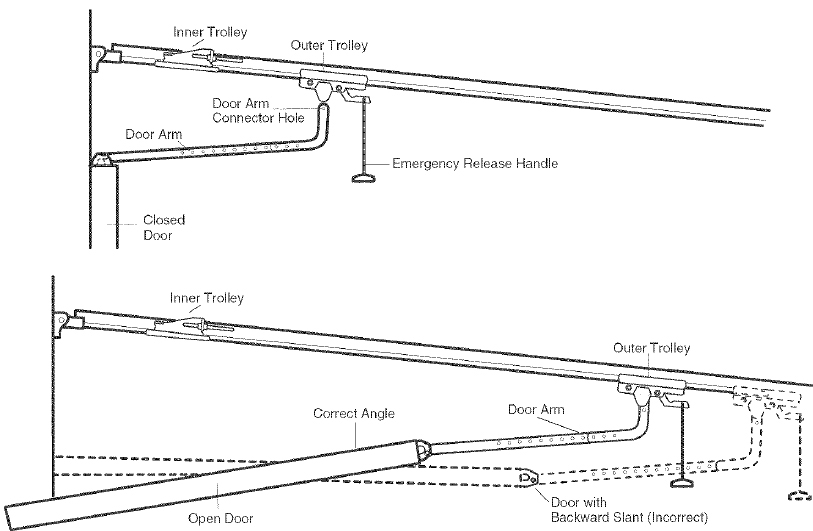
- On one-piece doors, before connecting the door arm to the trolley, the travel limits must be adjusted. Limit adjustment screws are located on the left side panel as shown on page 27. Follow adjustment procedures below.
- Open door adjustment: decrease UP travel limit
- Turn the UP limit adjustment screw counter-clockwise 5-1/2 turns.
- Press the Door Control push button. The trolley will travel to the fully open position.
- Manually raise the door to the open position (parallel to the floor), and lift the door arm to the trolley. The arm should touch the trolley just in back of the door arm connector hole. Refer to the fully open trolley/door arm positions in the illustration. If the arm does not extend far enough, adjust the limit further. One full turn equals 2" (5 cm) of trolley travel.
- Closed door adjustment: decrease DOWN travel limit
- Turn the DOWN limit adjustment screw clockwise 5 complete turns.
- Press the Door Control push button. The trolley will travel to the fully closed position.
- Manually close the door and lift the door arm to the trolley. The arm should touch the trolley just ahead of the door arm connector hole. Refer to the fully closed trolley/door arm positions in the illustration. If the arm is behind the connector hole, adjust the limit further. One full turn equals 2" (5 cm) of trolley travel.
3. Connect the door arm to the trolley:
- Close the door and join the curved arm to the connector hole in the trolley with the remaining clevis pin. It may be necessary to lift the door slightly to make the connection.
- Secure with a ring fastener.
- Run the opener through a complete travel cycle. If the door has a slight “backward” slant in full open position as shown in the illustration, decrease the UP limit until the door is parallel to the floor.
NOTE: When setting the up limit on the following page, the door should not have a “backward” slant when fully open as illustrated below. A slight backward slant will cause unnecessary bucking and/or jerking operation as the door is being opened or closed from the fully open position.
ADJUSTMENT STEP 1
Adjust the UP and DOWN Travel Limits
Limit adjustment settings regulate the points at which the door will stop when moving up or down.
To operate the opener, press the Door Control push bar. Run the opener through a complete travel cycle.
- Does the door open and close completely?
- Does the door stay closed and not reverse unintentionally when fully closed?
If your door passes both of these tests, no limit adjustments are necessary unless the reversing test fails (Adjustment Step 3, page 29).
Adjustment procedures are outlined below. Read the procedures carefully before proceeding to Adjustment Step 2. Use a screwdriver to make limit adjustments. Run the opener through a complete travel cycle after each adjustment.
NOTE: Repeated operation of the opener during adjustment procedures may cause the motor to overheat and shut off. Simply wait 15 minutes and try again.
NOTE: If anything interferes with the door’s upward travel, it will stop. If anything interferes with the door’s downward travel (including binding or unbalanced doors), it will reverse.
HOW AND WHEN TO ADJUST THE LIMITS
If the door does not open completely but opens at least five feet (1.5 m): Increase up travel. Turn the UP limit adjustment screw clockwise. One turn equals 2" (5 cm) of travel. NOTE: To prevent the trolley from hitting the cover protection bolt, keep a minimum distance of 2-4" (5-10 cm) between the trolley and the bolt.
If door does not open at least 5 feet ( 1.5 m): Adjust the UP (open) force as explained in Adjustment Step 2.
If the door does not close completely: Increase down travel. Turn the down limit adjustment screw counterclockwise. One turn equals 2" (5 cm) of travel. If door still won’t close completely and the trolley bumps into the pulley bracket (page 4), try lengthening the door arm (page 25) and decreasing the down limit.
If the opener reverses in fully closed position: Decrease down travel. Turn the down limit adjustment screw clockwise. One turn equals 2" (5 cm) of travel.
if the door reverses when closing and there is no visible interference to travel cycle: If the opener lights are flashing, the Safety Reversing Sensors are either not installed, misaligned, or obstructed. See Troubleshooting, page 22.
Test the door for binding: Pull the emergency release handle. Manually open and close the door. If the door is binding or unbalanced, call for a trained door systems technician. If the door is balanced and not binding, adjust the DOWN (close) force. See Adjustment Step 2.
 WARNING
WARNING
Without a properly installed safety reversal system, persons (particularly small children) could be SERIOUSLY INJURED or KILLED by a closing garage door.
- Incorrect adjustment of garage door travel limits will interfere with proper operation of safety reversal system.
- If one control (force or travel limits) is adjusted, the other control may also need adjustment.
- After ANY adjustments are made, the safety reversal system MUST be tested. Door MUST reverse on contact with 1-1/2" (3.8 cm) high object (or 2×4 laid flat) on floor.
CAUTION
To prevent damage to vehicles, be sure fully open door provides adequate clearance.
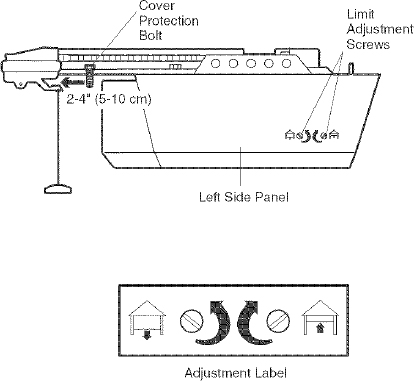
ADJUSTMENT STEP 2
Adjust the Force
Force adjustment controls are located on the back panel of the motor unit. Force adjustment settings regulate the amount of power required to open and close the door.
If the forces are set too light, door travel may be interrupted by nuisance reversals in the down direction and stops in the up direction. Weather conditions can affect the door movement, so occasional adjustment may be needed.
The maximum force adjustment range is about 3/4 of a complete turn. Do not force controls beyond that point. Turn force adjustment controls with a screwdriver.
NOTE: If anything interferes with the door’s upward travel, it will stop. If anything interferes with the door’s downward travel (including binding or unbalanced doors), it will reverse.
HOW AND WHEN TO ADJUST THE FORCES
- Test the DOWN (close) force
Grasp the door bottom when the door is about halfway through DOWN (close) travel. The door should reverse. Reversal halfway through down travel does not guarantee reversal on a 1-1/2" (3.8 cm) obstruction. See Adjustment Step 3, page 29.
If the door is hard to hold or doesn’t reverse, DECREASE the DOWN (close) force by turning the control counterclockwise. Make small adjustments until the door reverses normally. After each adjustment, run the opener through a complete cycle.
If the door reverses during the down (close) cycle and the opener lights aren’t flashing, INCREASE DOWN (close) force by turning the control clockwise. Make small adjustments until the door completes a close cycle. After each adjustment, run the opener through a complete travel cycle. Do not increase the force beyond the minimum amount required to close the door.
- Test the UP (open) force
- Grasp the door bottom when the door is about halfway through UP (open) travel. The door should stop. If the door is hard to hold or doesn’t stop, DECREASE UP (open) force by turning the control counterclockwise. Make small adjustments until the door stops easily and opens fully. After each adjustment, run the opener through a complete travel cycle.
- If the door doesn’t open at least 5 feet (1.5 m), INCREASE UP (open) force by turning the control clockwise. Make small adjustments until door opens completely. Readjust the UP limit if necessary. After each adjustment, run the opener through a complete travel cycle.
 WARNING
WARNING
Without a properly installed safety reversal system, persons (particularly small children) could be SERIOUSLY INJURED or KILLED by a closing garage door.
- Too much force on garage door will interfere with proper operation of safety reversal system.
- NEVER increase force beyond minimum amount required to close garage door.
- NEVER use force adjustments to compensate for a binding or sticking garage door.
- If one control (force or travel limits) is adjusted, the other control may also need adjustment.
- After ANY adjustments are made, the safety reversal system MUST be tested. Door MUST reverse on contact with 1-1/2" (3.8 cm) high object (or 2×4 laid flat) on floor.
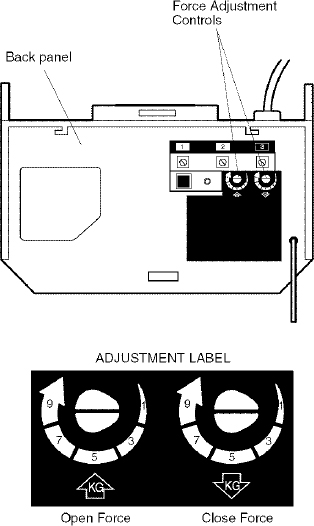
ADJUSTMENT STEP 3
Test the Safety Reversal System
TEST
- With the door fully open, place a 1-1/2" (3.8 cm) board (or a 2×4 laid flat) on the floor, centered under the garage door.
- Operate the door in the down direction. The door must reverse on striking the obstruction.
ADJUST
If the door stops on the obstruction, it is not traveling far enough in the down direction. Increase the DOWN limit by turning the DOWN limit adjustment screw counterclockwise 1/4 turn.
NOTE: On a sectional door, make sure limit adjustments do not force the door arm beyond a straight up and down position. See the illustration on page 25.
Repeat the test.
When the door reverses on the 1-1/2" (3.8 cm) board, remove the obstruction and run the opener through 3 or 4 complete travel cycles to test adjustment.
IMPORTANT SAFETY CHECK:
Repeat Adjustment Steps 1, 2 and 3 after:
- Each adjustment of door arm length, limits, or force controls.
- Any repair to or adjustment of the garage door (including springs and hardware).
- Any repair to or buckling of the garage floor.
- Any repair to or adjustment of the opener.
 WARNING
WARNING
Without a properly installed safety reversal system, persons (particularly small children) could be SERIOUSLY INJURED or KILLED by a closing garage door.
- Safety reversal system MUST be tested every month.
- If one control (force or travel limits) is adjusted, the other control may also need adjustment.
- After ANY adjustments are made, the safety reversal system MUST be tested. Door MUST reverse on contact with 1-1/2" (3.8 cm) high object (or 2×4 laid flat) on the floor.
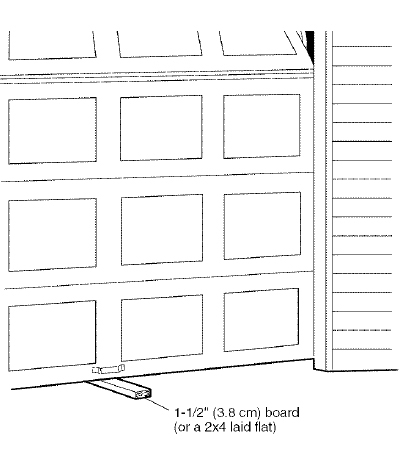
ADJUSTMENT STEP 4
Test the Protector System®
- Press the remote control push button to open the door.
- Place the opener carton in the path of the door.
- Press the remote control push button to close the door. The door will not move more than an inch, and the opener lights will flash.
The garage door opener will not close from a remote if the indicator light in either sensor is off (alerting you to the fact that the sensor is misaligned or obstructed).
If the opener closes the door when the safety reversing sensor is obstructed (and the sensors are no more than 6" (15 cm) above the floor), call for a trained door systems technician.
 WARNING
WARNING
Without a properly installed safety reversing sensor, persons (particularly small children) could be SERIOUSLY INJURED or KILLED by a closing garage door.
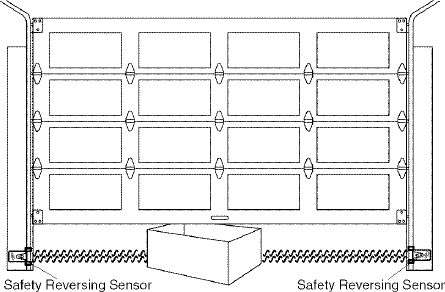
OPERATION
IMPORTANT SAFETY INSTRUCTIONS
 WARNING
WARNING
To reduce the risk of severe injury or death:
- READ AND FOLLOW ALL WARNINGS AND INSTRUCTIONS.
- ALWAYS keep remote controls out of reach of children. NEVER permit children to operate or play with garage door control push buttons or remote controls.
- ONLY activate garage door when it can be seen clearly, it is properly adjusted, and there are no obstructions to door travel.
- ALWAYS keep garage door in sight until completely closed. NO ONE SHOULD CROSS THE PATH OF THE MOVING DOOR.
- NO ONE SHOULD GO UNDER A STOPPED, PARTIALLY OPEN DOOR.
- If possible, use emergency release handle to disengage trolley ONLY when garage door is CLOSED. Weak or broken springs or unbalanced door could result in an open door falling rapidly and/or unexpectedly.
- NEVER use emergency release handle unless garage doorway is clear of persons and obstructions.
- NEVER use handle to pull garage door open or closed. If rope knot becomes untied, you could fall.
- If one control (force or travel limits) is adjusted, the other control may also need adjustment.
- After ANY adjustments are made, the safety reversal system MUST be tested.
- Safety reversal system MUST be tested every month. Garage door MUST reverse on contact with 1-1/2" (3.8 cm) high object (or a 2 × 4 laid flat) on the floor.
- ALWAYS KEEP GARAGE DOOR PROPERLY BALANCED (see page 3). An improperly balanced door may not reverse when required and could result in SEVERE INJURY or DEATH.
- All repairs to cables, spring assemblies and other hardware, all of which are under EXTREME tension, MUST be made by a trained door systems technician.
- ALWAYS disconnect electric power to garage door opener BEFORE making any repairs or removing covers.
- SAVE THESE INSTRUCTIONS.
Using Your Garage Door Opener
Your Security ® opener and hand-held remote control have been factory-set to a matching code which changes with each use, randomly accessing over 100 billion new codes. Your opener will operate with up to eight Security
® opener and hand-held remote control have been factory-set to a matching code which changes with each use, randomly accessing over 100 billion new codes. Your opener will operate with up to eight Security ® remote controls and one Security
® remote controls and one Security ® Keyless Entry System. If you purchase a new remote, or if you wish to deactivate any remote, follow the instructions in the Programming section.
® Keyless Entry System. If you purchase a new remote, or if you wish to deactivate any remote, follow the instructions in the Programming section.
Activate your opener with any of the following:
- The hand-held Remote Control: Hold the large push button down until the door starts to move.
- The wall-mounted Door Control: Hold the push button or bar down until the door starts to move.
- The Keyless Entry (See Accessories): If provided with your garage door opener, it must be programmed before use. See Programming.
When the opener is activated (with the safety reversing sensor correctly installed and aligned)
- If open, the door will close. If closed, it will open.
- If closing, the door will reverse.
- If opening, the door will stop.
- If the door has been stopped in a partially open position, it will close.
- If obstructed while closing, the door will reverse. If the obstruction interrupts the sensor beam, the opener lights will blink for five seconds.
- If obstructed while opening, the door will stop.
- If fully open, the door will not close when the beam is broken. The sensor has no effect in the opening cycle.
If the sensor is not installed, or is misaligned, the door won’t close from a hand-held remote. However, you can close the door with the Door Control, the Outside Keylock, or Keyless Entry, if you activate them until down travel is complete. If you release them too soon, the door will reverse.
The opener lights will turn on under the following conditions: when the opener is initially plugged in; when power is restored after interruption; when the opener is activated.
They will turn off automatically after 4-1/2 minutes. Bulb size is 75 watts maximum.
Using the Wall-Mounted Door Control
THE DOOR CONTROL
Press the push bar to open or close the door. Press again to reverse the door during the closing cycle or to stop the door while it’s opening.
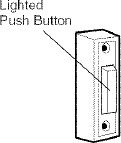
To Open the Door Manually
 WARNING
WARNING
To prevent possible SERIOUS INJURY or DEATH from a falling garage door:
- If possible, use emergency release handle to disengage trolley ONLY when garage door is CLOSED. Weak or broken springs or unbalanced door could result in an open door falling rapidly and/or unexpectedly.
- NEVER use emergency release handle unless garage doorway is clear of persons and obstructions.
NEVER use handle to pull door open or closed. If rope knot becomes untied, you could fall.
The door should be fully closed if possible. Pull down on the emergency release handle and lift the door manually. To reconnect the door to the opener, press the door control push bar.
MANUAL DISCONNECT POSITION
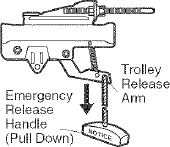
The lockout feature prevents the trolley from reconnecting automatically. Pull the emergency release handle down and back (toward the opener). The door can then be raised and lowered manually as often as necessary. To disengage the lockout feature, pull the handle straight down. The trolley will reconnect on the next UP or DOWN operation.
LOCKOUT POSITION
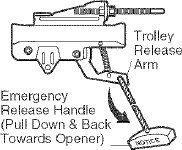
CARE OF YOUR OPENER
LIMIT AND FORCE ADJUSTMENTS:
Weather conditions may cause some minor changes in door operation requiring some re-adjustments, particularly during the first year of operation.
FORCE CONTROL

Pages 27 and 28 refer to the limit and force adjustments. Only a screwdriver is required. Follow the instructions carefully.
LIMIT CONTROLS

Repeat the safety reverse test (Adjustment Step 3, page 29) after any adjustment of limits or force.
THE REMOTE CONTROL BATTERY
 WARNING
WARNING
To prevent possible SERIOUS INJURY or DEATH:
- NEVER allow small children near batteries.
- If battery is swallowed, immediately notify doctor.
The lithium battery should produce power for up to 5 years. To replace battery, use the visor clip or screwdriver blade to pry open the case as shown. Insert battery positive side up (+).
Dispose of old battery properly.

NOTICE: To comply with FCC and or Industry Canada rules (IC), adjustment or modifications of this receiver and/or transmitter are prohibited, except for changing the code setting or replacing the battery. THERE ARE NO OTHER USER SERVICEABLE PARTS. Tested to Comply with FCC Standards FOR HOME OR OFFICE USE. Operation is subject to the following two conditions: (1) this device may not cause harmful interference, and (2) this device must accept any interference received, including interference that may cause undesired operation.
MAINTENANCE SCHEDULE
Once a Month
- Manually operate door. If it is unbalanced or binding, call a trained door systems technician.
- Check to be sure door opens & closes fully. Adjust limits and/or force if necessary. (See pages 27 and 28.)
- Repeat the safety reverse test. Make any necessary adjustments. (See Adjustment Step 3.)
Twice a Year
- Check chain tension. Disconnect trolley first. Adjust if necessary (See page 11).
Once a Year
- Oil door rollers, bearings and hinges. The opener does not require additional lubrication. Do not grease the door tracks.
HAVING A PROBLEM?
My door will not close and the light bulbs blink on my motor unit: The safety reversing sensor must be connected and aligned correctly before the garage door opener will move in the down direction.
- Verify the safety sensors are properly installed, aligned and free of any obstructions. Refer to Installation Step 10: Install The Protector System®,
- Check diagnostic LED for flashes on the motor unit then refer to the Diagnostic Chart on the following page.
My remotes will not activate the door:
- Reprogram remotes following the programming instructions. Refer to Programming.
- If remote will still not activate your door, check diagnostic LED for flashes on motor unit then refer to Diagnostic Chart on the following page.
My door reverses for no apparent reason: Repeat safety reverse test after adjustments to force or travel limits. The need for occasional adjustment for the force and limit settings is normal. Weather conditions in particular can affect door travel.
- Manually check door for balance or any binding problems.
- Refer to Adjustment Step 2, Adjust the Force.
My door reverses for no apparent reason after fully closing and touching the floor: Repeat safety reverse test after adjustments to force or travel limits. The need for occasional adjustment for the force and limit settings is normal. Weather conditions in particular can affect door travel.
- Refer to Adjustment Step 1, Adjust the UP and DOWN Travel Limits. Decrease down travel by turning down limit adjustment screw clockwise.
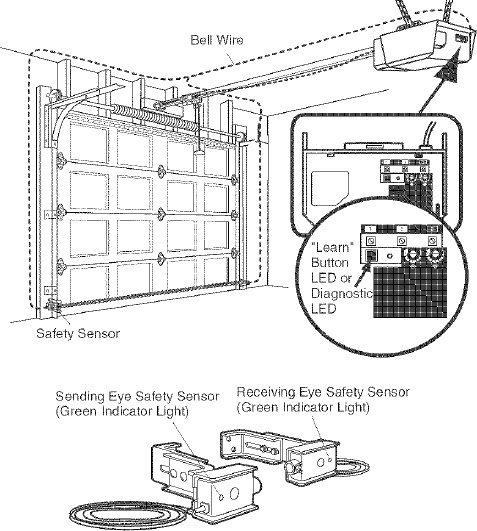
- My motor unit hums briefly:
- First verify that the trolley is against the stop bolt.
- Release the door from the opener by pulling the Emergency Release Rope.
- Manually bring the door to a closed position.
- Loosen the chain by adjusting the outer nut 4 to 5 turns. This relieves the tension.
- Run the motor unit from the remote control or door control. The trolley should travel towards the door and stop. If the trolley re-engages with the door, pull the Emergency Release Rope to disengage.
- Decrease the UP travel by turning the UP Travel adjustment screw 2 full turns away from the arrow.
- Re-tighten the outer nut so the chain is a 1/2" (13 mm) above the base of the rail. (When the door is reconnected and closed, the chain will sag. This is normal.)
- If the trolley does not move away from the bolt, repeat the steps above.
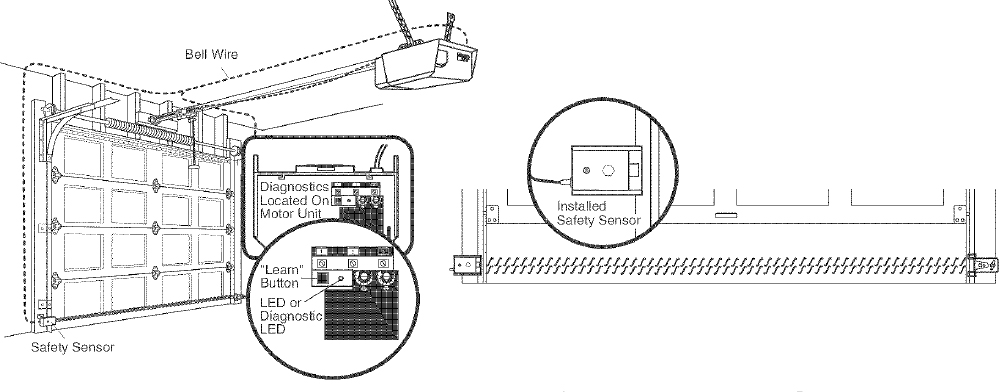
Your garage door opener is programmed with self-diagnostic capabilities. The “Learn” button/diagnostic LED will flash a number of times then pause signifying it has found a potential issue. Consult Diagnostic Chart below.
Diagnostic Chart
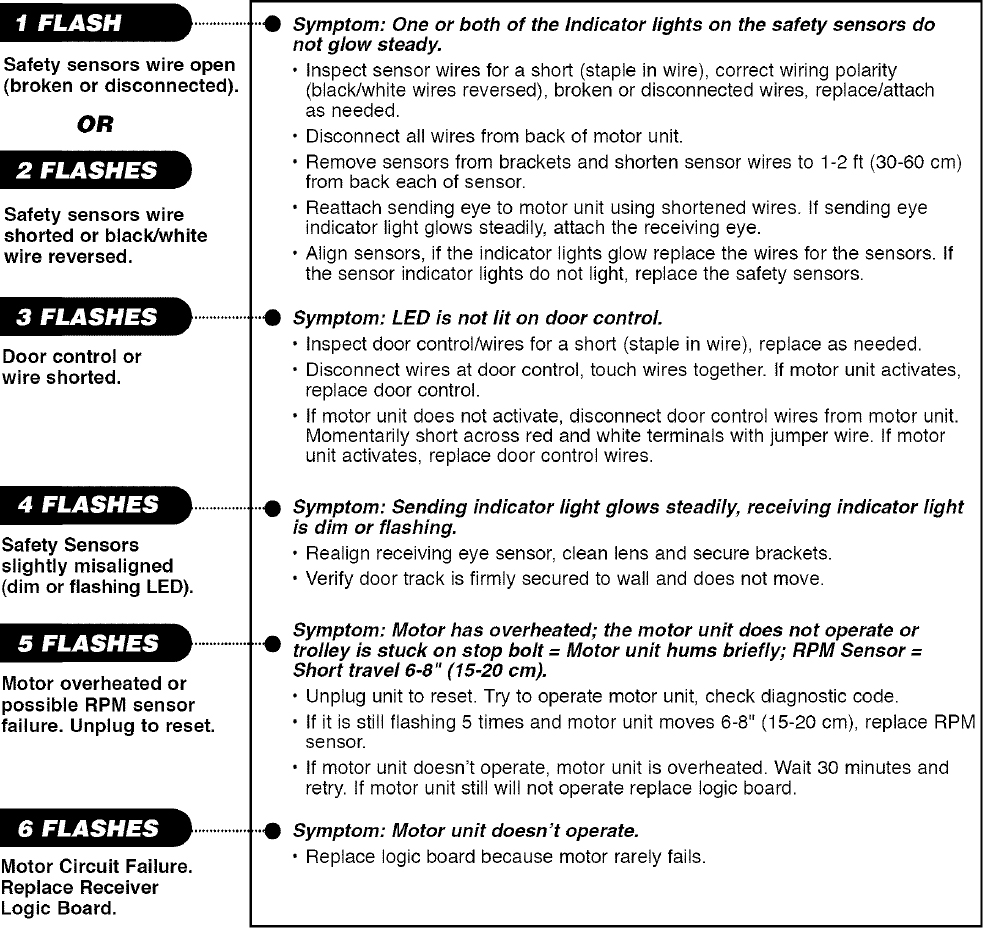
PROGRAMMING
NOTICE: If this Security ® garage door opener is operated with a non-rolling code transmitter, the technical measure in the receiver of the garage door opener, which provides security against code-theft devices, will be circumvented. The owner of the copyright in the garage door opener does not authorize the purchaser or supplier of the non-rolling code transmitter to circumvent that technical measure.
® garage door opener is operated with a non-rolling code transmitter, the technical measure in the receiver of the garage door opener, which provides security against code-theft devices, will be circumvented. The owner of the copyright in the garage door opener does not authorize the purchaser or supplier of the non-rolling code transmitter to circumvent that technical measure.
Your garage door opener has already been programmed at the factory to operate with your hand-held remote control. The door will open and close when you press the large push button.
Below are instructions for programming your opener to operate with additional Security ® remote controls.
® remote controls.
To Add or Reprogram a Hand-held Remote Control
USING THE “LEARN” BUTTON
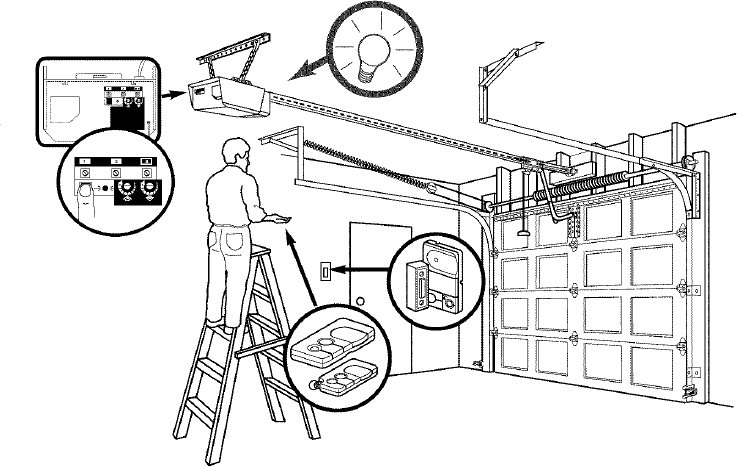
- Press and release the “learn” button on the motor unit. The learn indicator light will glow steadily for 30 seconds.
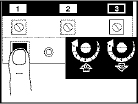
- Within 30 seconds, press and hold the button on the hand-held remote* that you wish to operate your garage door.
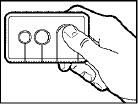
- Release the button when the motor unit lights blink. It has learned the code. If light bulbs are not installed, two clicks will be heard.

To Erase All Codes From Motor Unit Memory
To deactivate any unwanted remote, first erase all codes:
Press and hold the “learn” button on motor unit until the learn indicator light goes out (approximately 6 seconds). All previous codes are now erased. Reprogram each remote or keyless entry you wish to use.

*3-Function Remotes
If provided with your garage door opener, the large button is factory programmed to operate it. Additional buttons on any Security ® 3-Function remote or compact remote can be programmed to operate other Security
® 3-Function remote or compact remote can be programmed to operate other Security ® garage door openers.
® garage door openers.
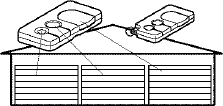
To Add, Reprogram or Change a Keyless Entry PIN
NOTE: Your new Keyless Entry must be programmed to operate your garage door opener.
USING THE “LEARN” BUTTON
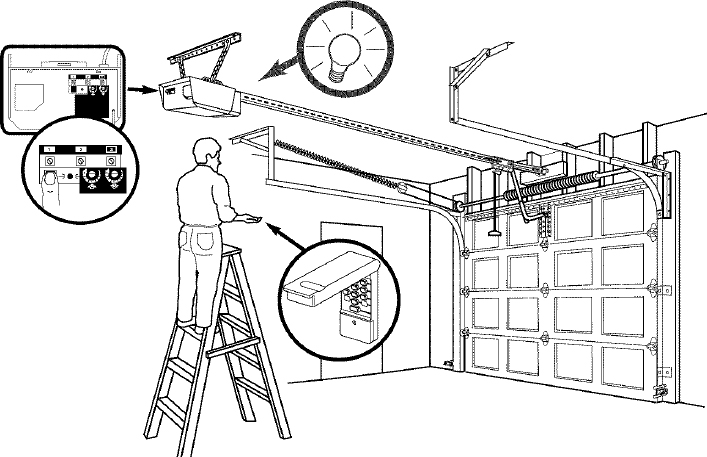
- Press and release the “learn” button on motor unit. The learn indicator light will glow steadily for 30 seconds.
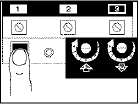
- Within 30 seconds, enter a four digit personal identification number (PIN) of your choice on the keypad. Then press and hold the ENTER button.
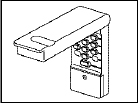
- Release the button when the motor unit lights blink. It has learned the code. If light bulbs are not installed, two clicks will be heard.

To change an existing, known PIN
If the existing PIN is known, it may be changed by one person without using a ladder.
- Press the four buttons for the present PIN, then press and hold the # button. The opener light will blink twice. Release the # button.
- Press the new 4-digit PIN you have chosen, then press Enter.
The motor unit lights will blink once when the PIN has been learned.
Test by pressing the new PIN, then press Enter. The door should move.
To set a temporary PIN
You may authorize access by visitors or service people with a temporary 4-digit PIN. After a programmed number of hours or number of accesses, this temporary PIN expires and will no longer open the door. It can be used to close the door even after it has expired. To set a temporary PIN:
- Press the four buttons for your personal entry PIN (not the last temporary PIN), then press and hold the * button. The opener light will blink three times. Release the button.
- Press the temporary 4-digit PIN you have chosen, then press Enter. The opener light will blink four times.
- To set the number of hours this temporary PIN will work, press the number of hours (up to 255), then press *.
OR
- To set the number of times this temporary PIN will work, press the number of times (up to 255), then press #.
The opener light will blink once when the temporary PIN has been learned.
Test by pressing the four buttons for the temporary PIN, then press Enter. The door should move. If the temporary PIN was set to a certain number of openings, remember that the test has used up one opening.To clear the temporary password, repeat steps 1-3, setting the number of hours or times to 0 in step 3.
REPAIR PARTS
Rail Assembly Parts
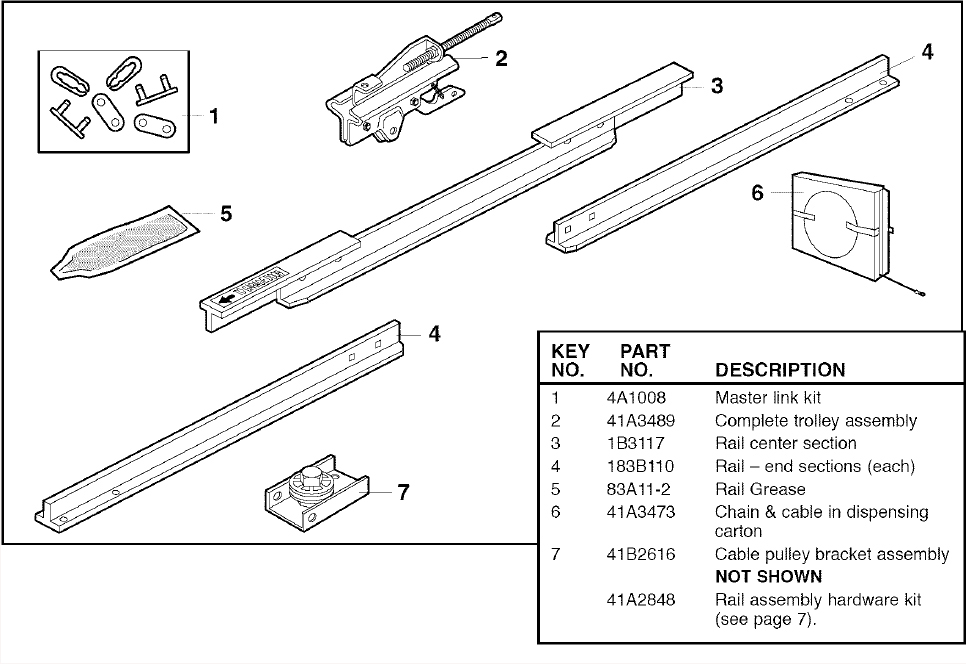
Installation Parts
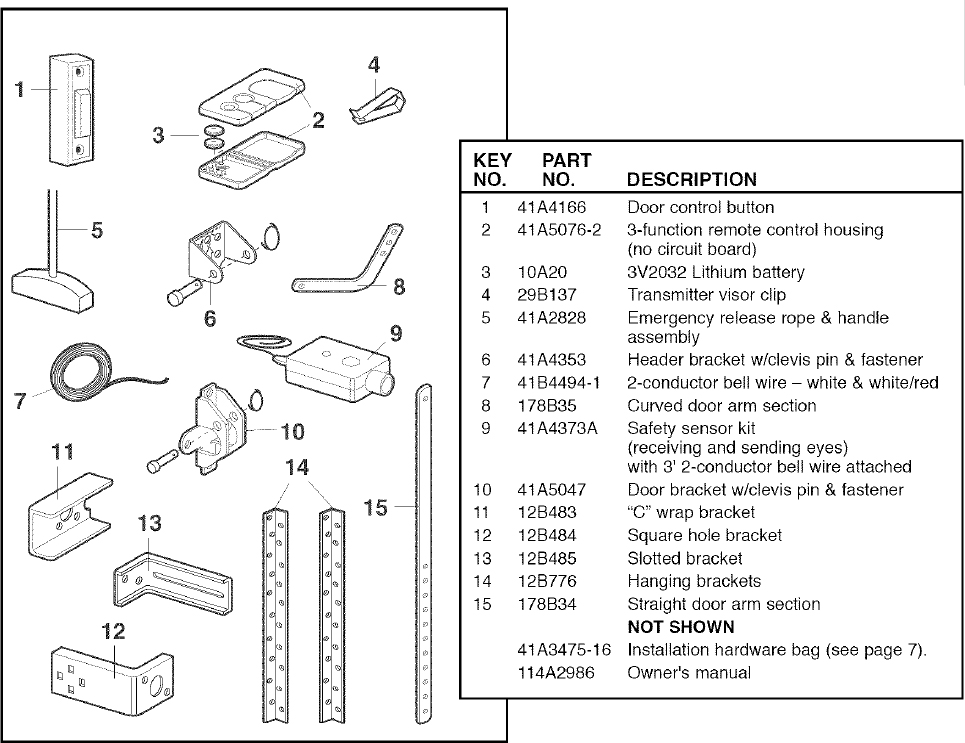
Motor Unit Assembly Parts
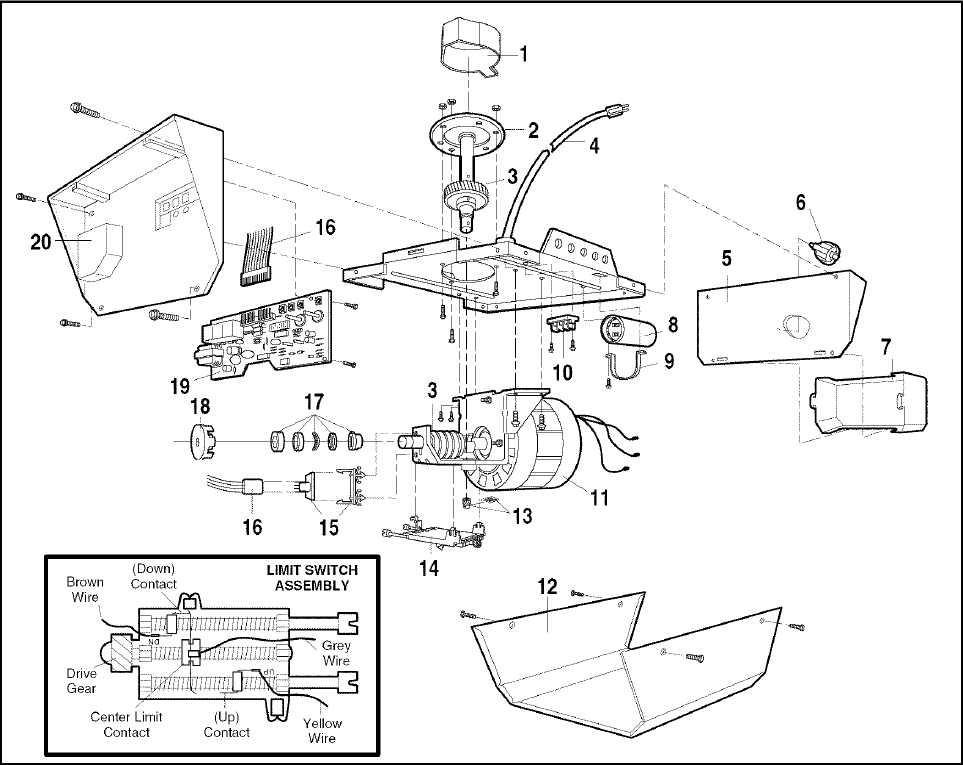
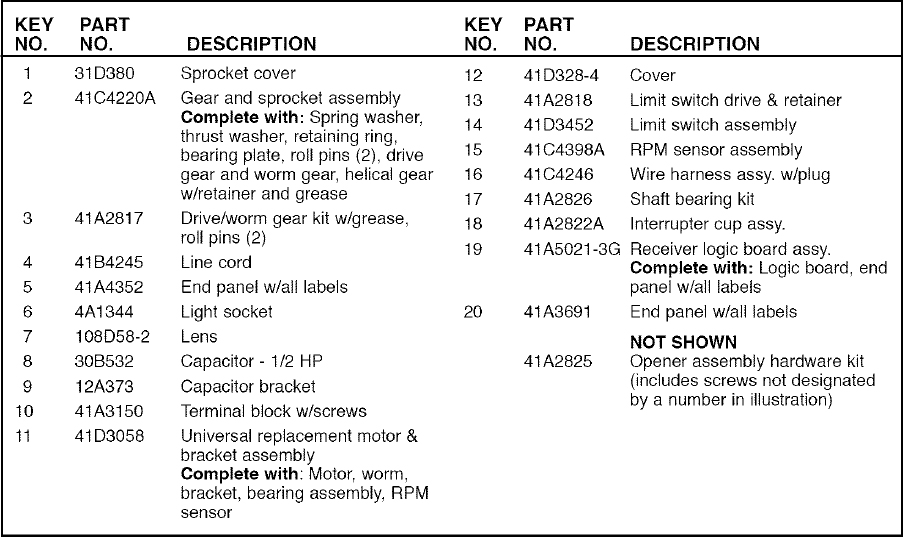
ACCESSORIES
| 139.53702 | Emergency Key Release: |
|---|---|
 |
Required for a garage with NO access door. Enables homeowner to open garage door manually from outside by disengaging trolley. |
| 139.53687 | Premium Control Console: |
 |
Provides a lock feature to prevent operation of garage door from portable remotes. A light feature controls the opener lights. Can be used to program the opener to accept additional remotes. |
| 139.53704 | 8 (2.4 m) Foot Rail Extension |
 |
To allow an 8 (2.4 m) foot door to open fully. |
| 139.53705 | 10 (3 m) Foot Rail Extension: |
 |
To allow a 10 (3 m) foot door to open fully. |
| 139.53589 | Support Brackets: |
 |
For finished ceilings or where additional support is required, based on garage construction. Includes brackets and fastening hardware. |
| 139.53681 | Security ® 3-Function Remote Control: ® 3-Function Remote Control: |
 |
Includes visor clip. |
| 139.53680 | Security ® Compact 3-Function Remote Control: ® Compact 3-Function Remote Control: |
 |
With loop for attaching key ring. |
| 139.53684 | Multi-Function Keyless Entry: |
 |
Enables homeowner to operate garage door opener from outside by entering a 4 digit code on specially designed keypad. |
| 139.53786 | Plug-In Light Control: |
 |
Enables homeowner to turn on a lamp, television or other appliance from car, bedside, or anywhere in the home with a remote. |
| 139.53709 | Door Clearance Brackets: |
 |
(For Sectional Doors Only) Replaces top brackets and rollers on door to reduce height of door travel. For use when installing opener in garage with low headroom clearance. |
WARRANTY
SEARS WARRANTY
FULL 90-DAY WARRANTY ON GARAGE DOOR OPENER
For 90 days from the date of purchase, Sears will repair this Garage Door Opener, free of charge, if defective in material or workmanship.
LIMITED WARRANTY
From the 91st day up to 1 years from the date of purchase, Sears will furnish replacement parts for any defective parts, free of charge. You pay for labor.
LIMITED WARRANTY ON MOTOR
From the 91st day and through 5 years, if the motor on this Garage Door Opener is defective, Sears will furnish a replacement motor, free of charge. You pay for labor.
LIMITATION ON LIABILITY
SEARS WILL NOT BE LIABLE FOR LOSS OR DAMAGE TO PROPERTY OR ANY INCIDENTAL OR CONSEQUENTIAL LOSS OR EXPENSE FROM PROPERTY DAMAGE DUE DIRECTLY OR INDIRECTLY TO THE USE OF THIS PRODUCT. Some states do not allow the exclusion or limitation of incidental or consequential damages, so the above limitation or exclusion may not apply to you. This warranty does not cover light bulbs or repair parts necessary because of operator abuse or negligence, including the failure to install, adjust and operate this garage door opener according to instructions contained in the owner’s manual. WARRANTY SERVICE IS AVAILABLE BY CONTACTING THE NEAREST SEARS SERVICE CENTER IN THE UNITED STATES.
This warranty applies only while this product is in use in the United States.
This warranty gives you specific legal rights, and you may also have other rights which vary from state to state.
Sears, Roebuck and Co., Dept. 817WA, Hoffman Estates, IL 60179
Repair Parts and Service
